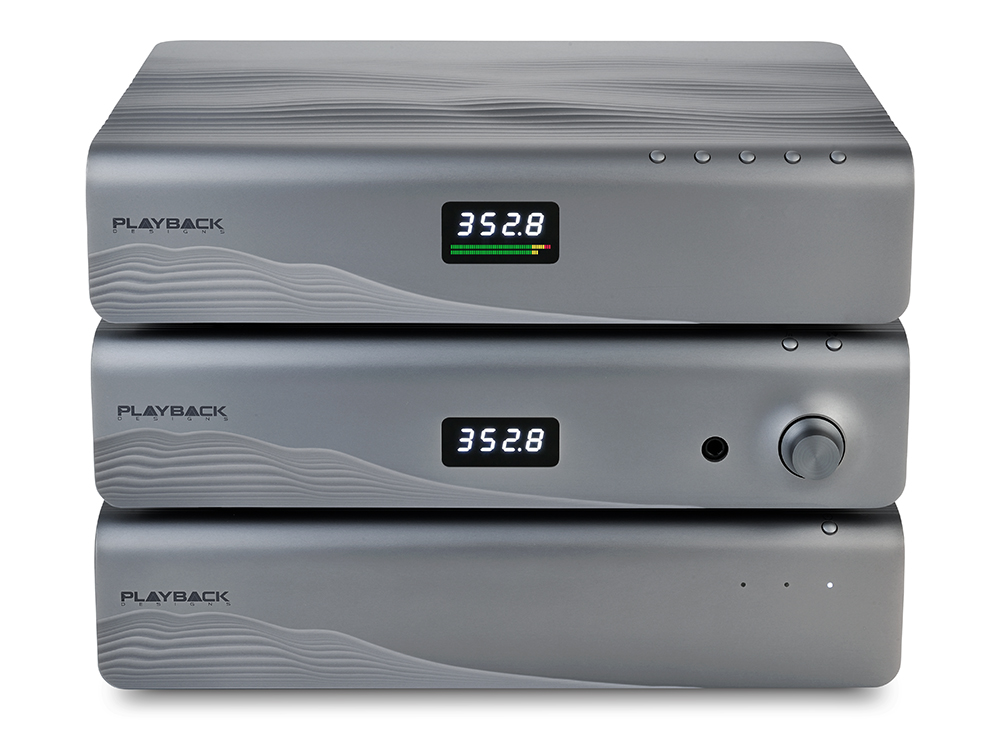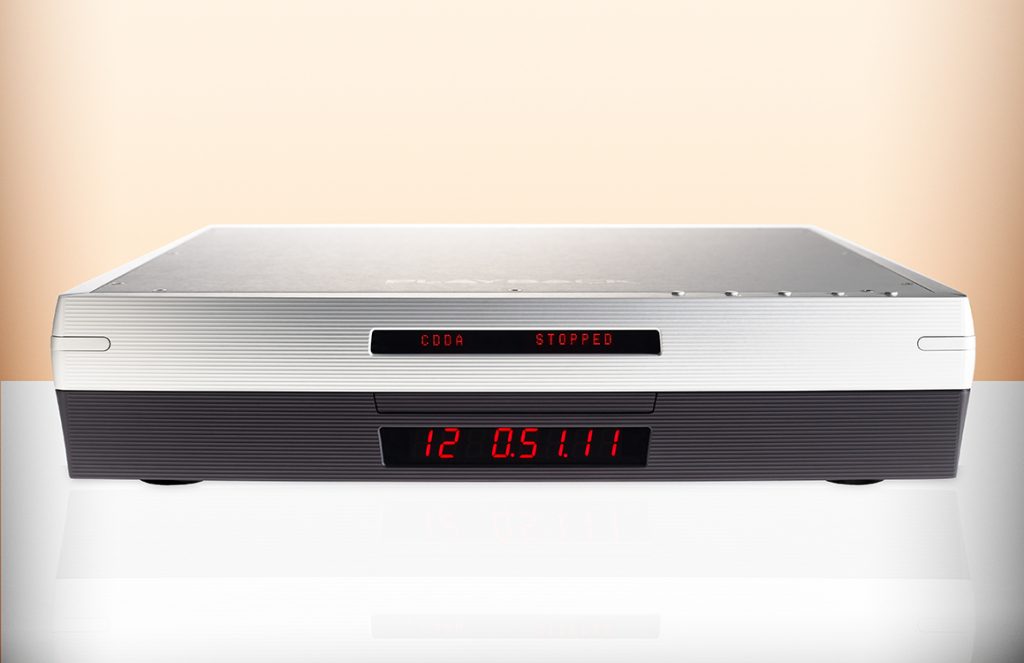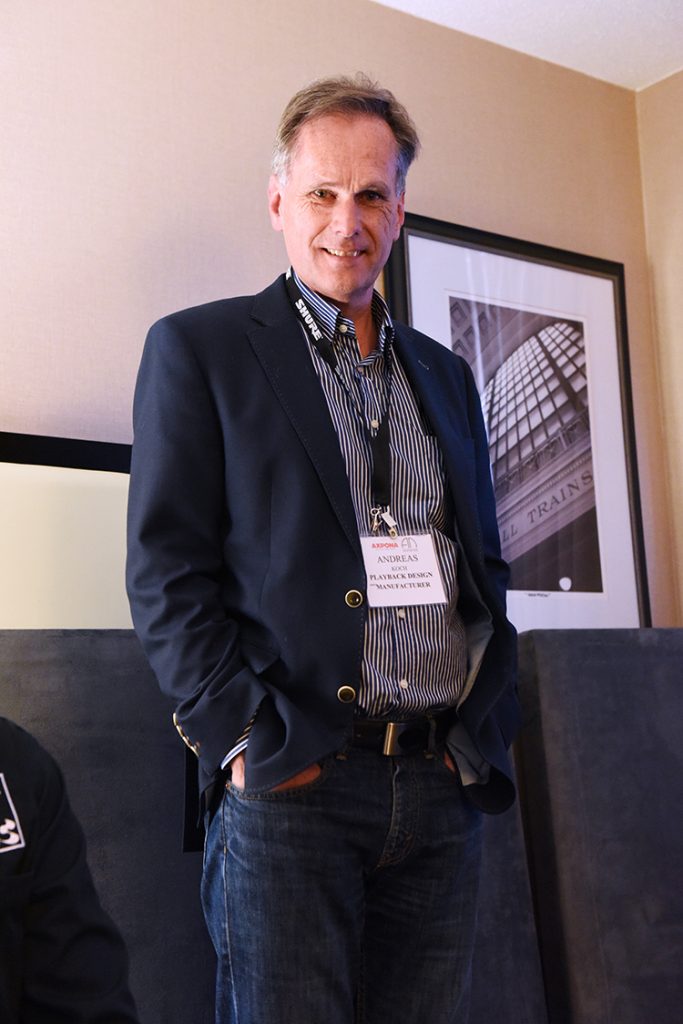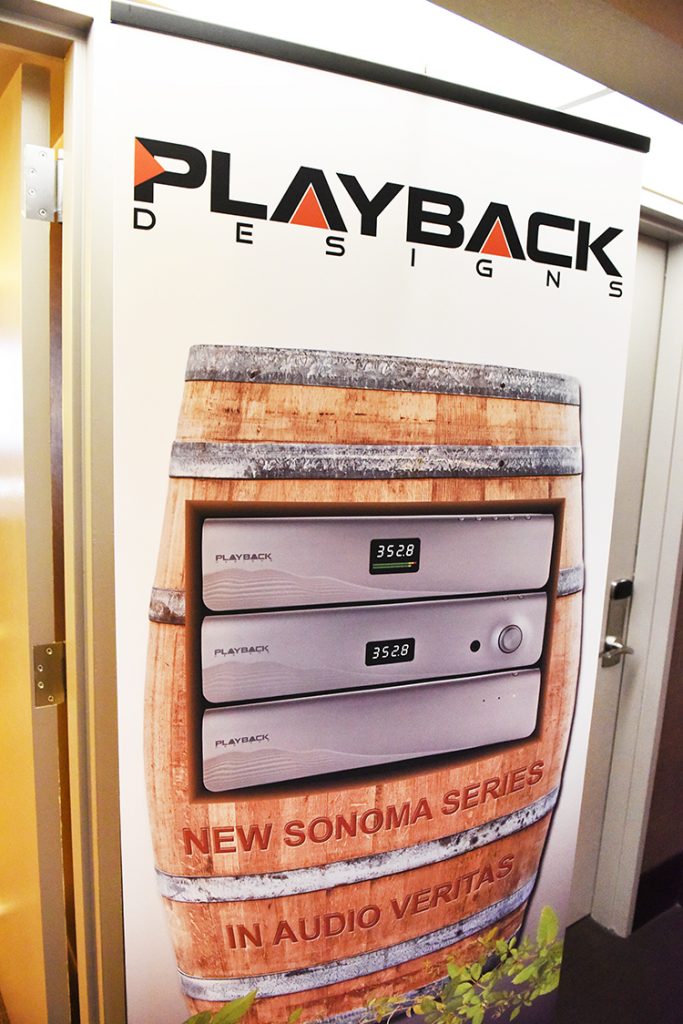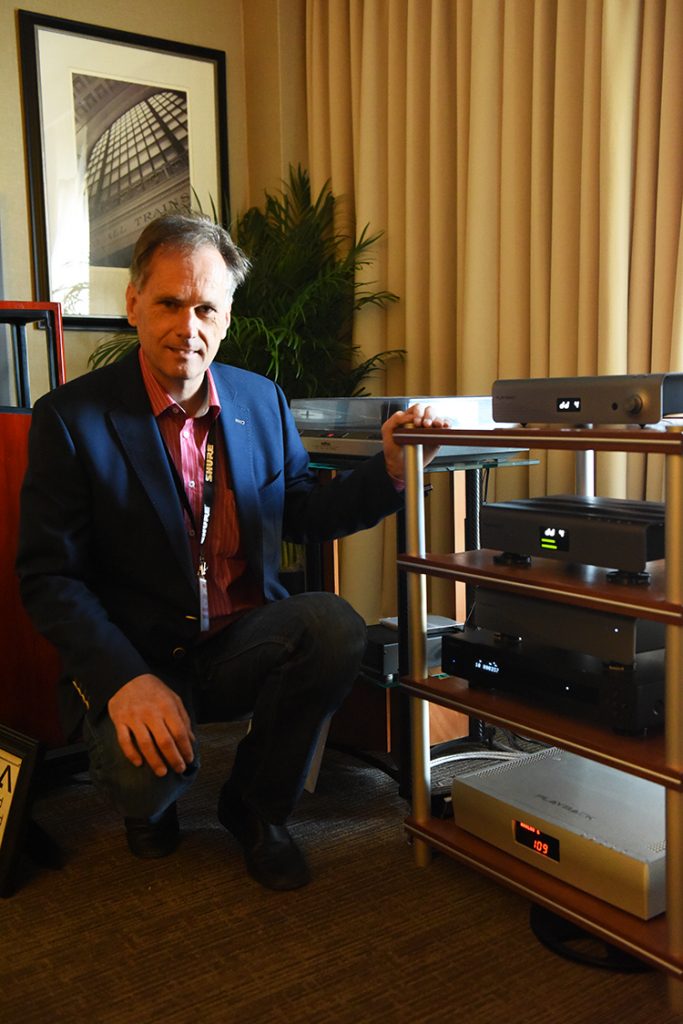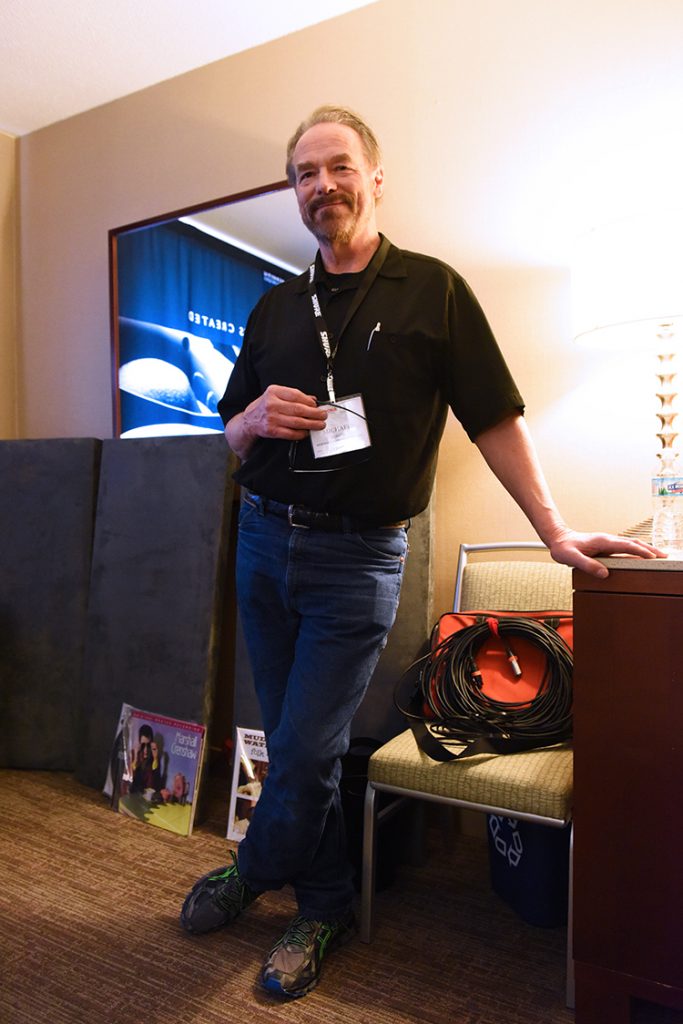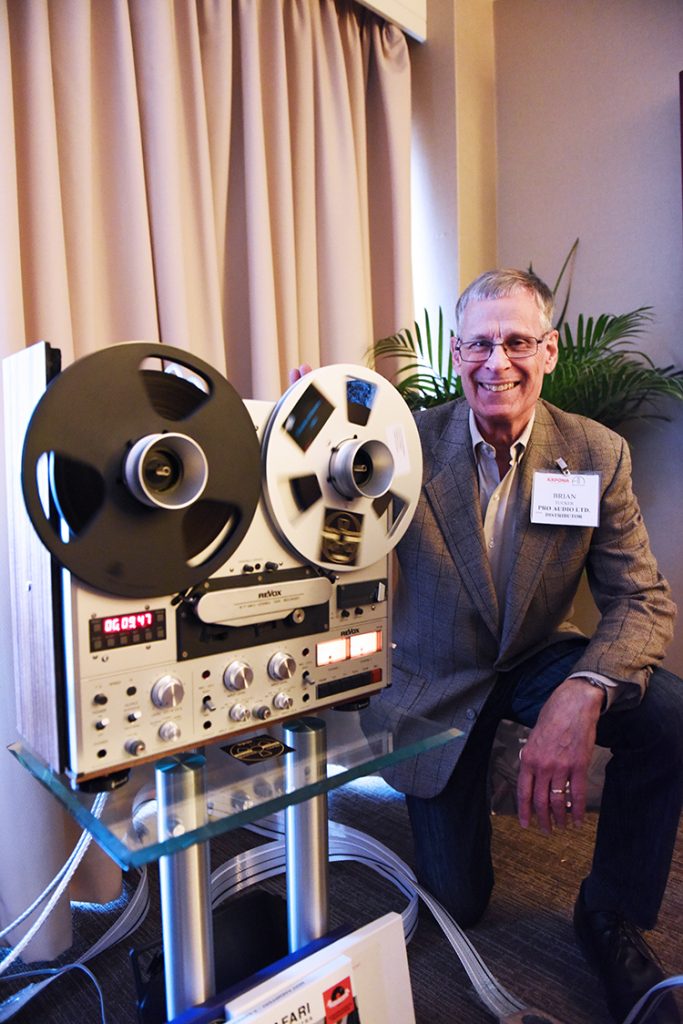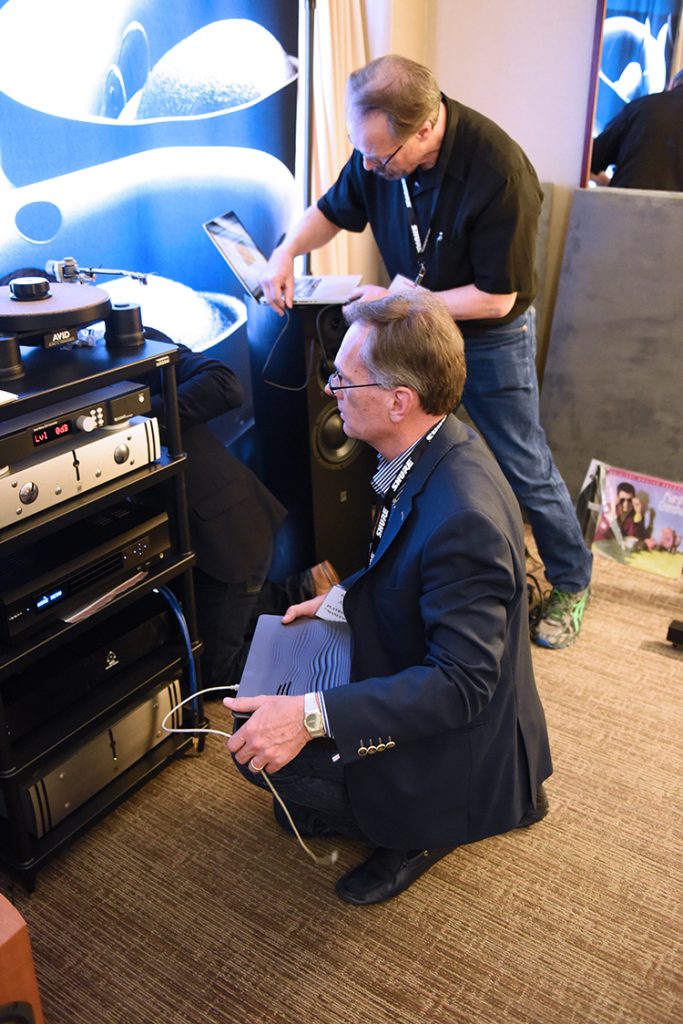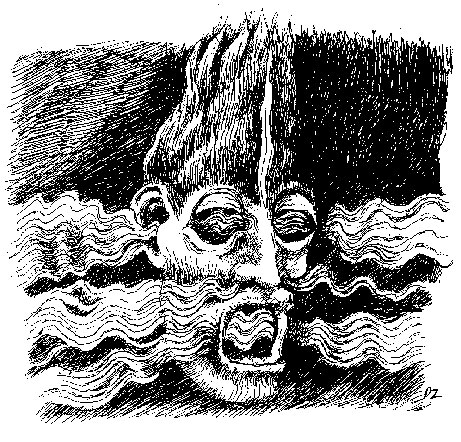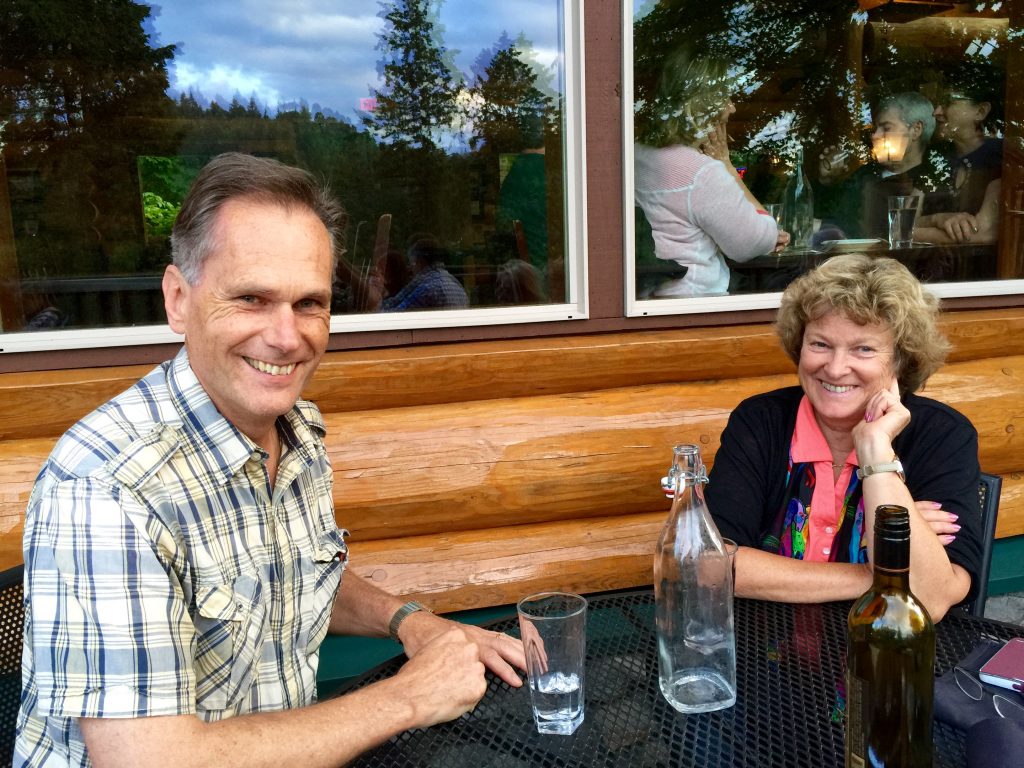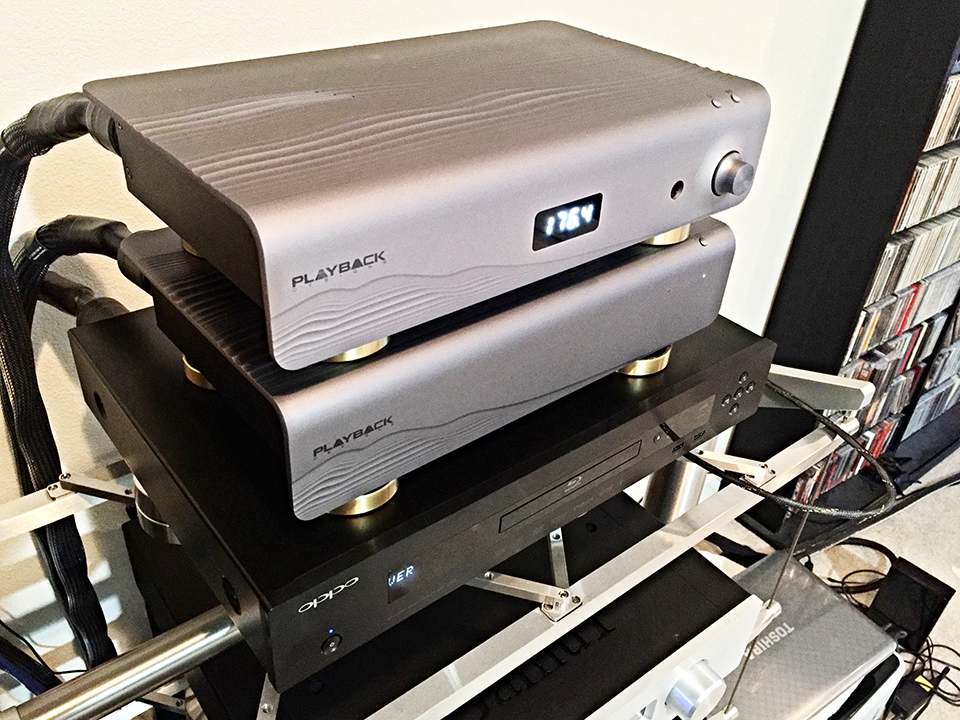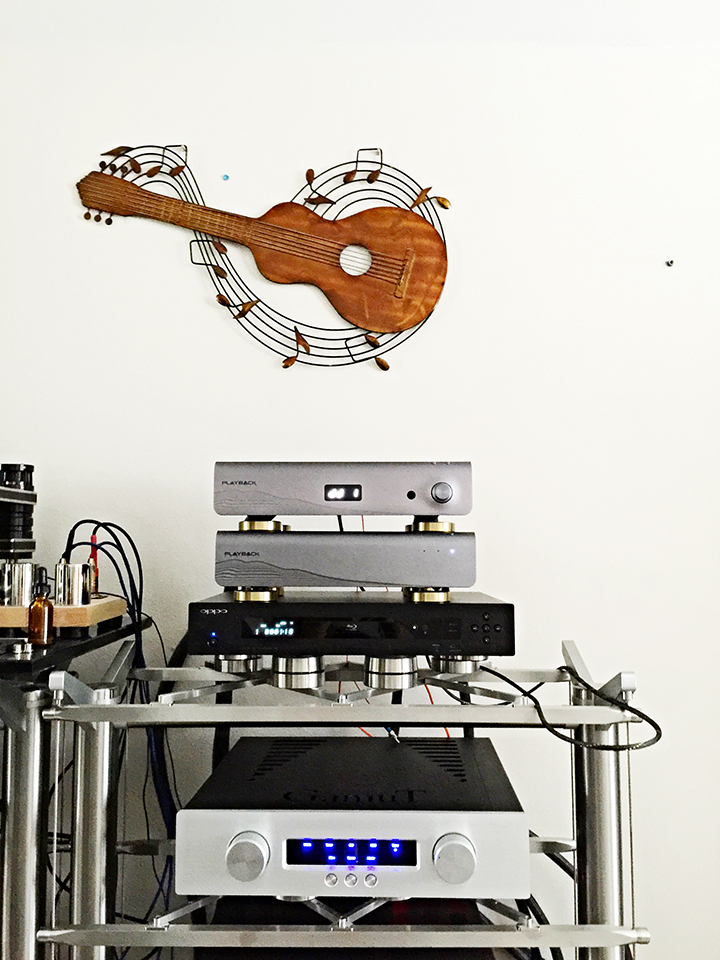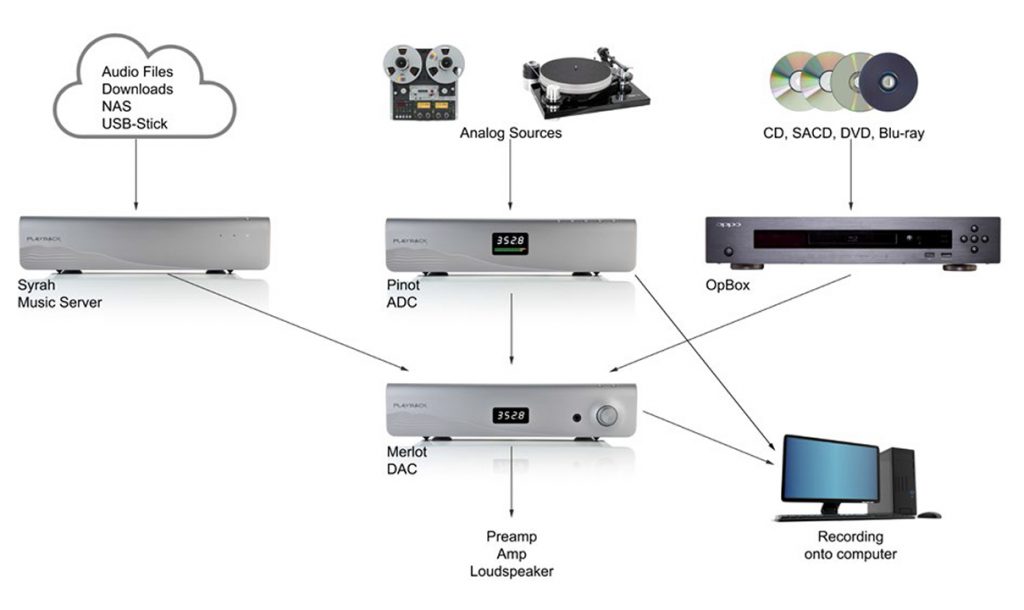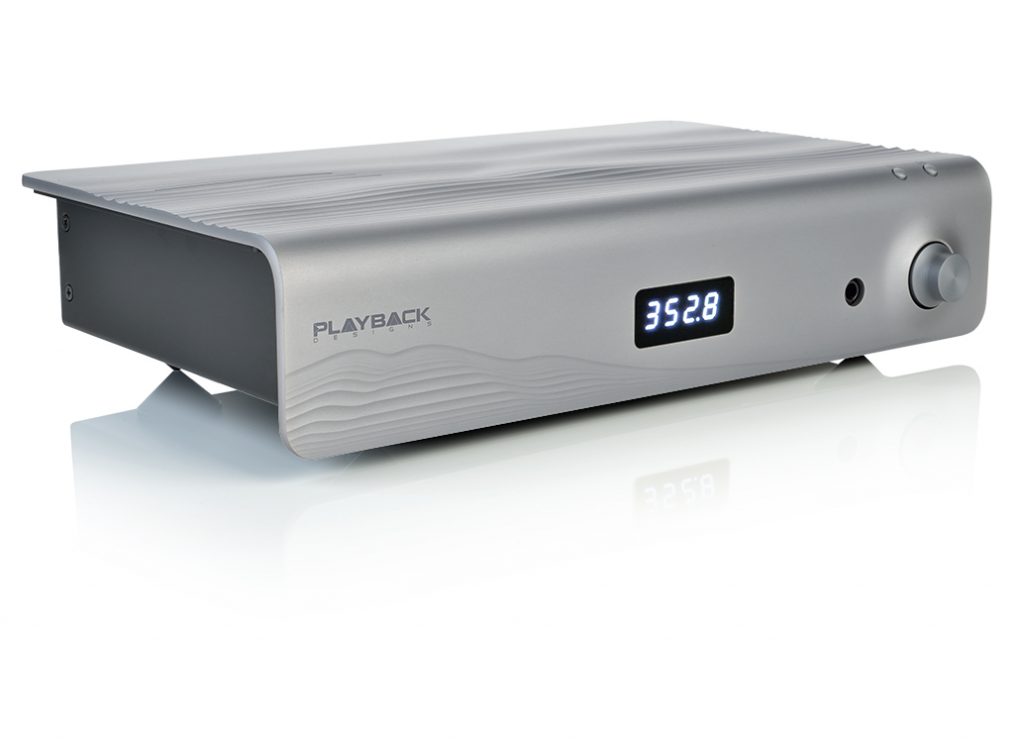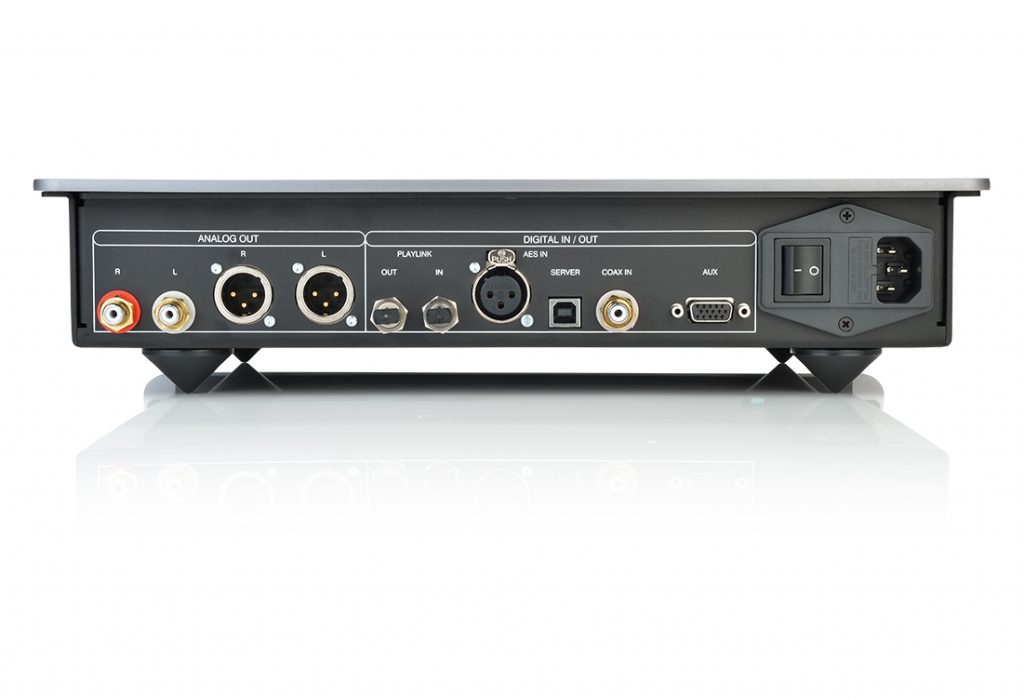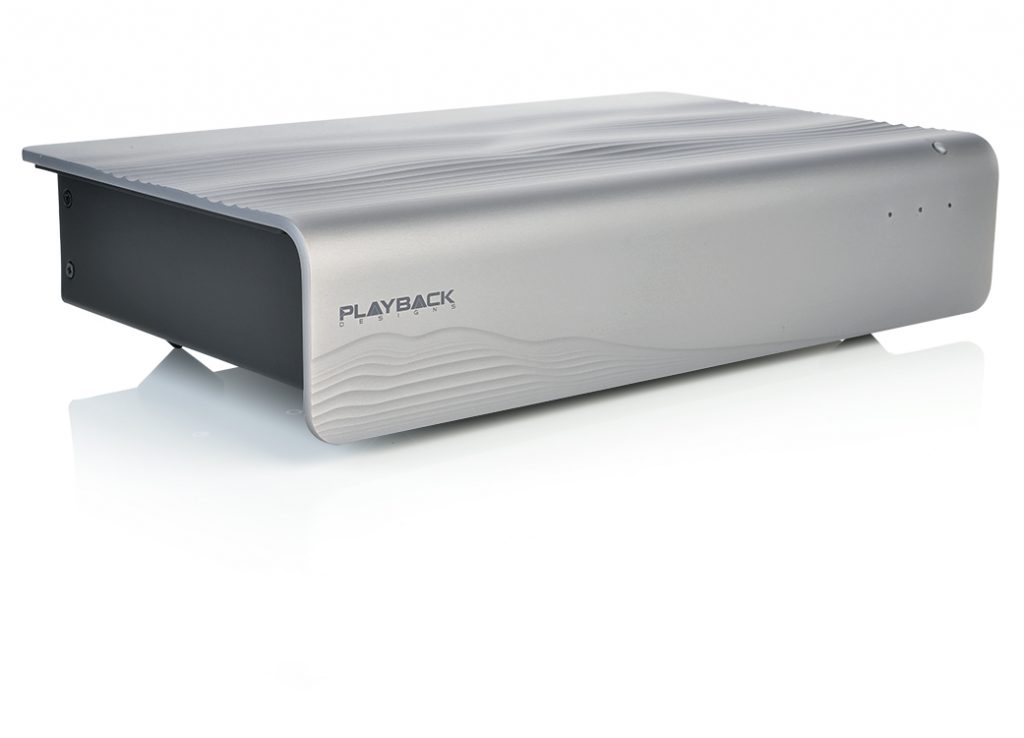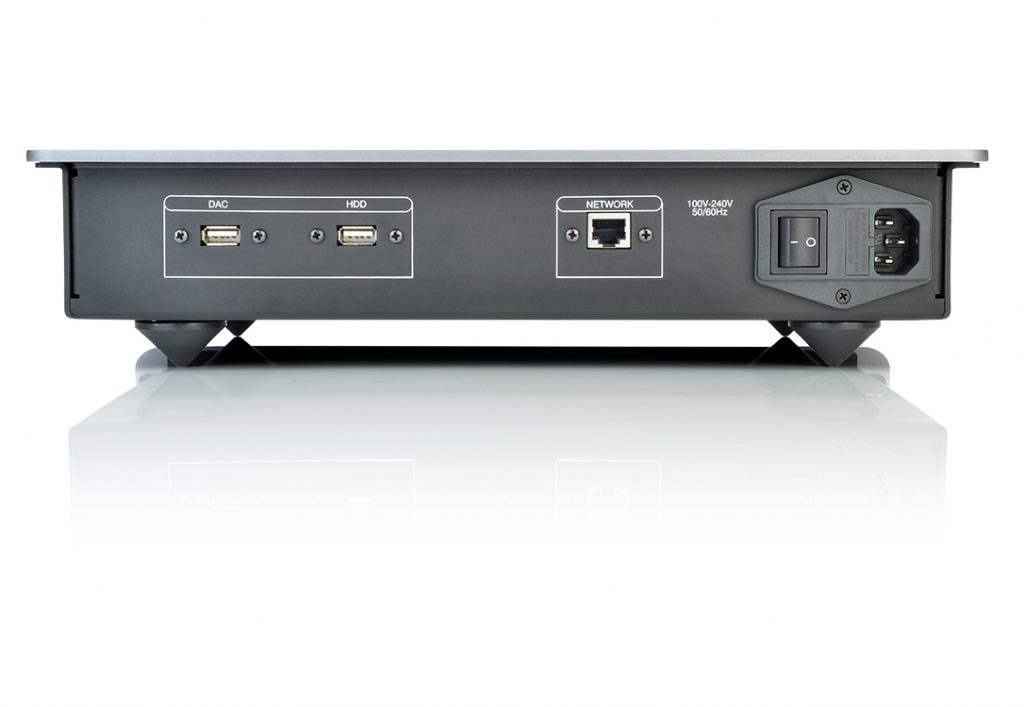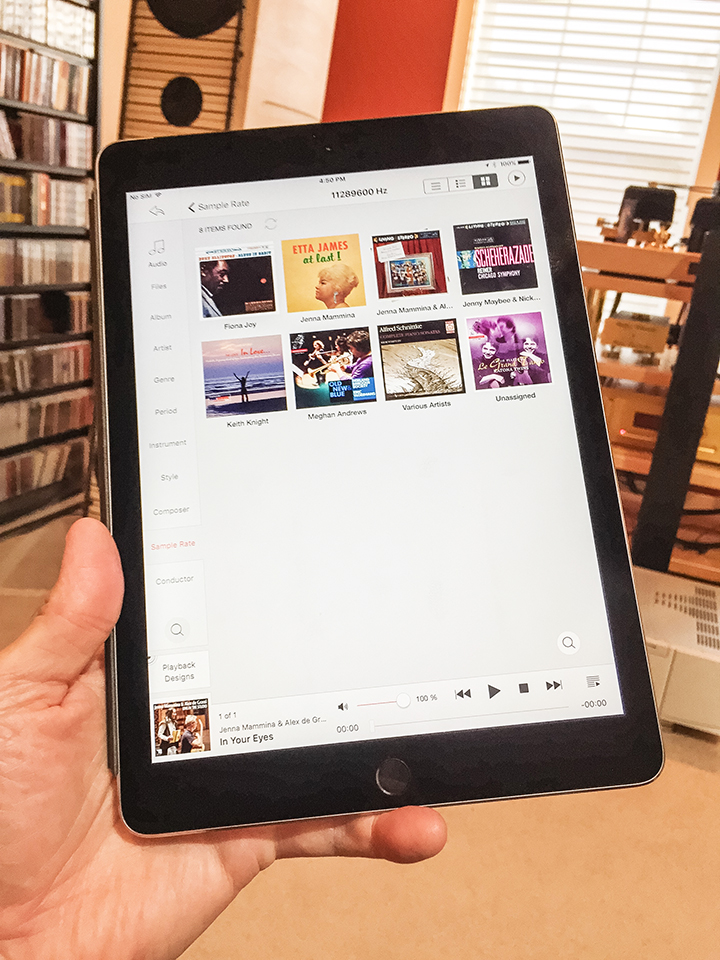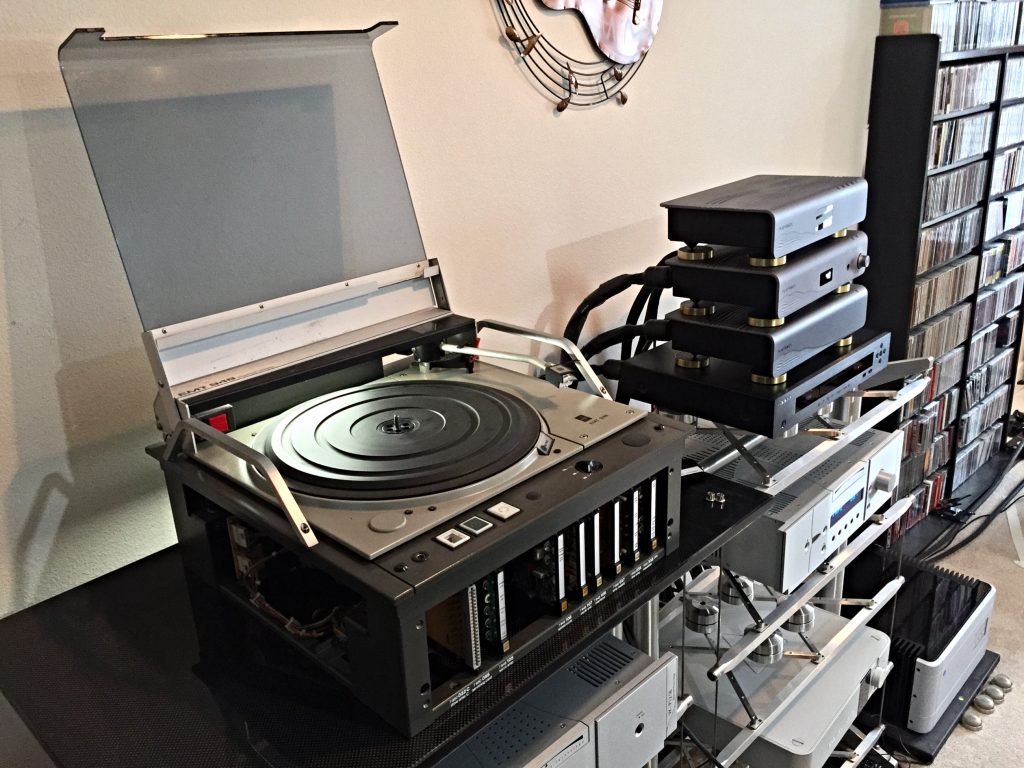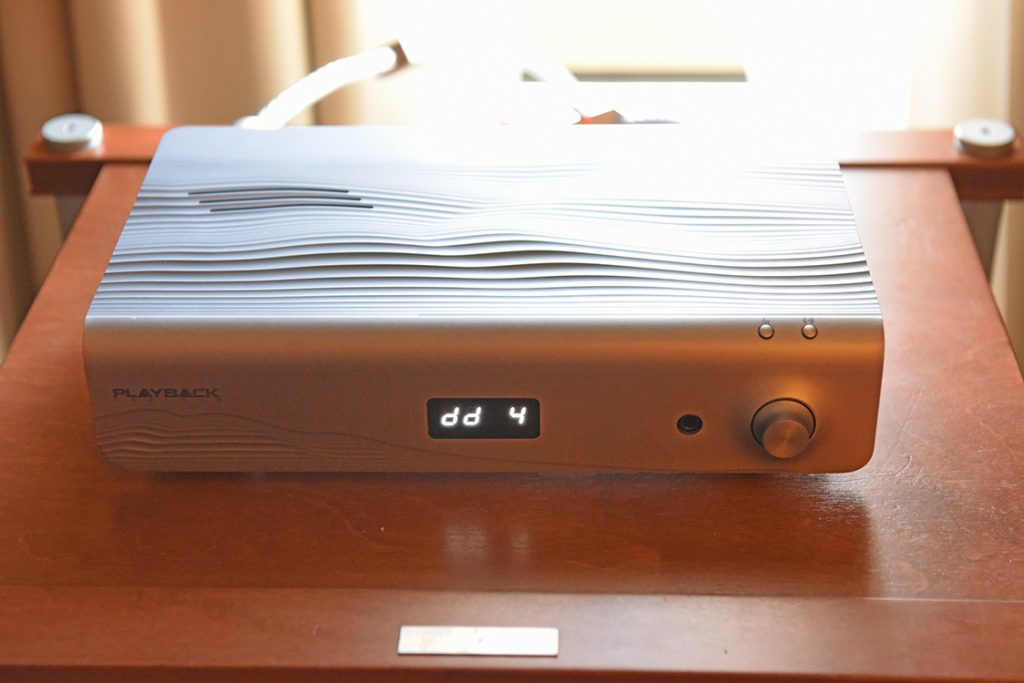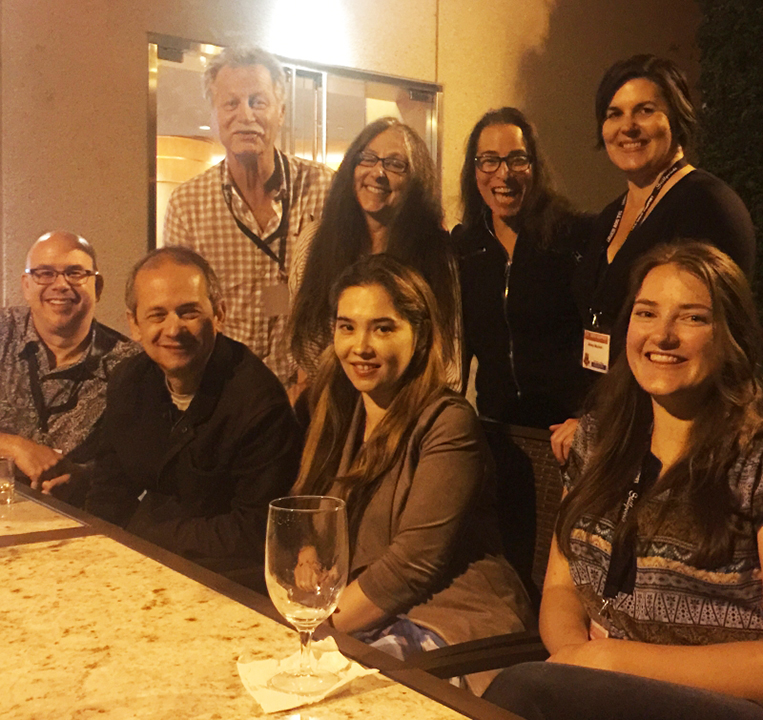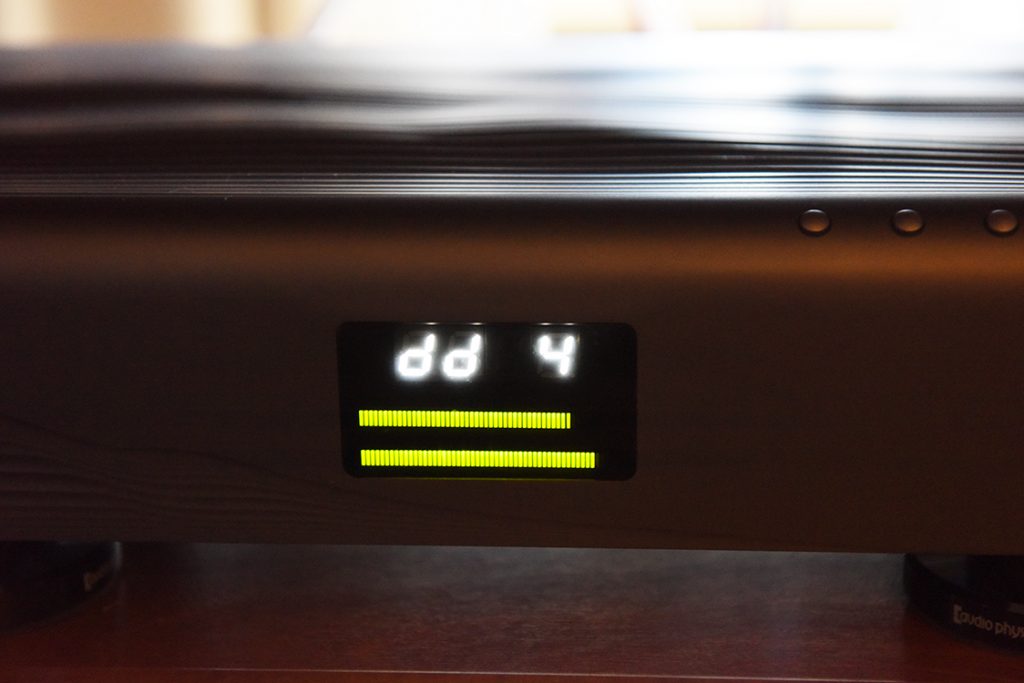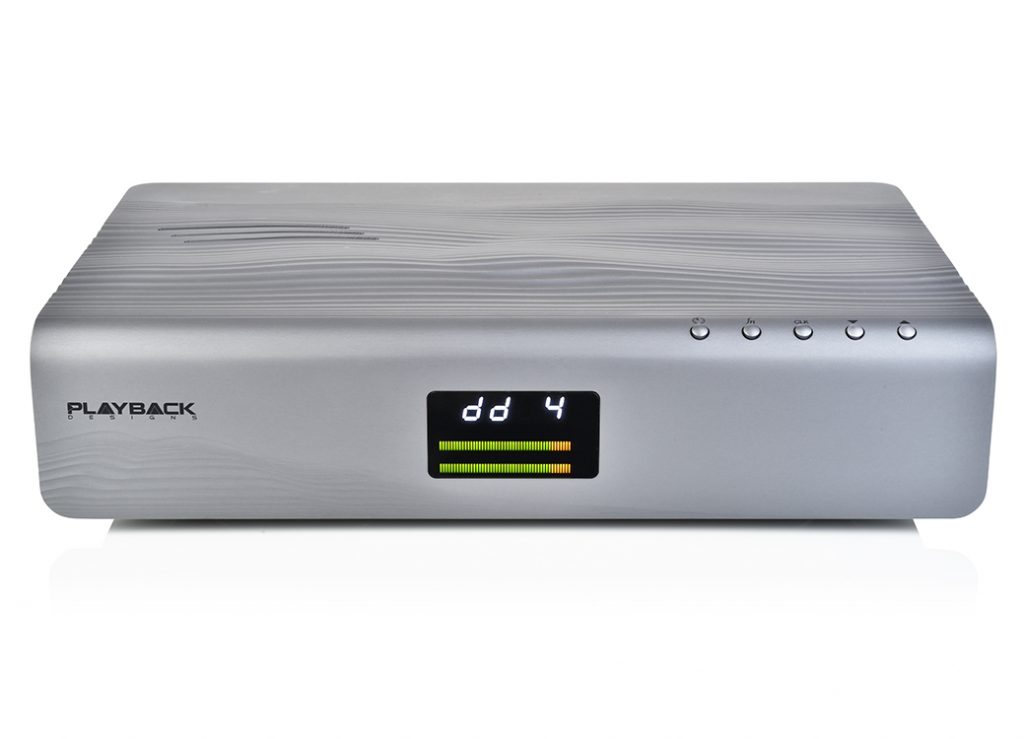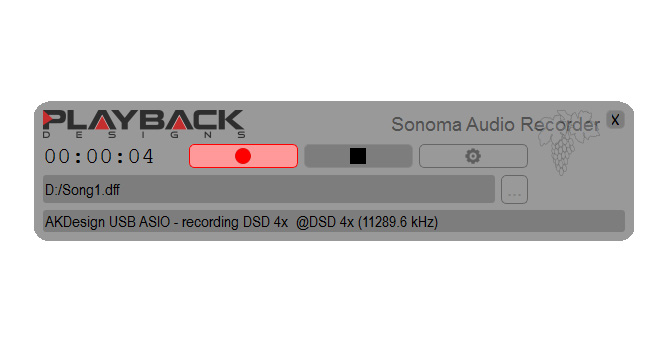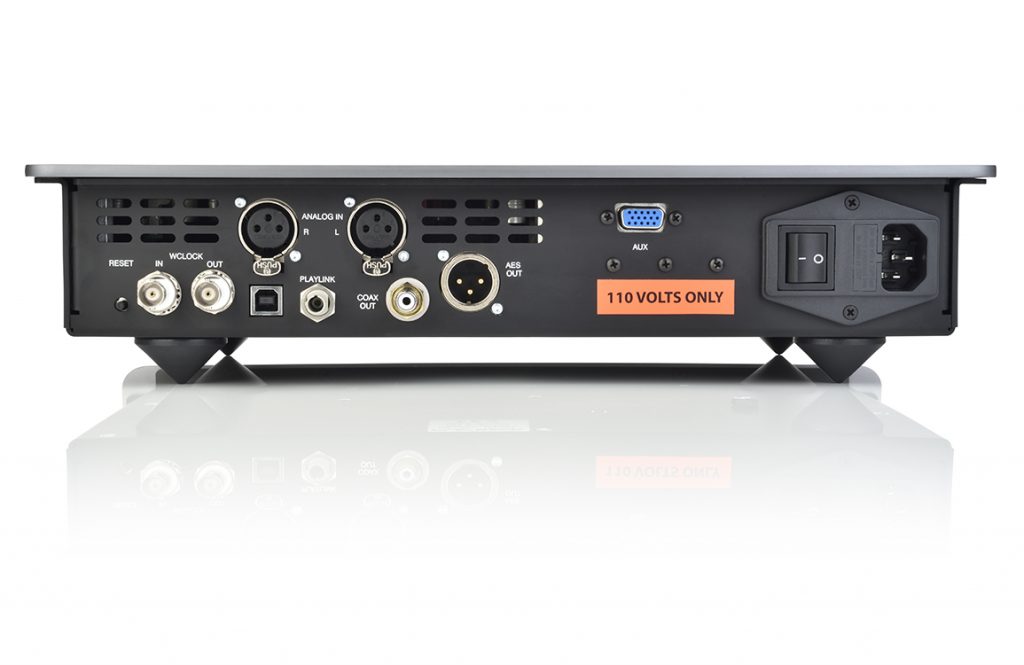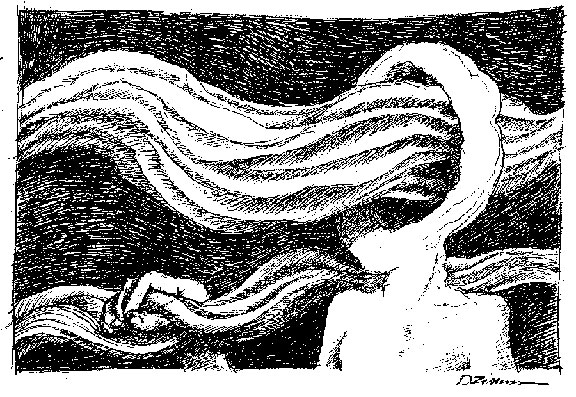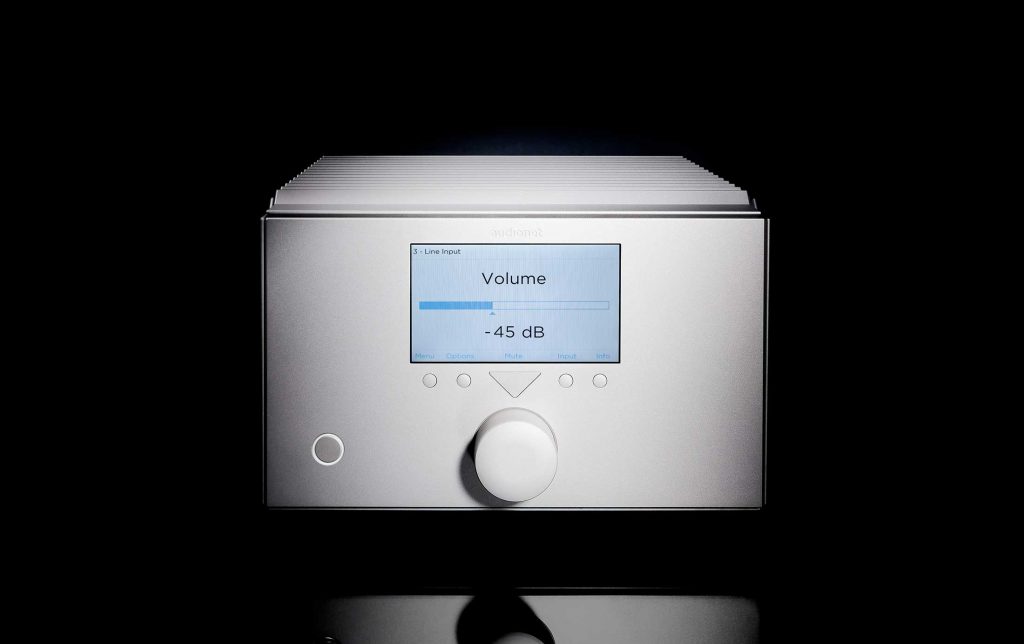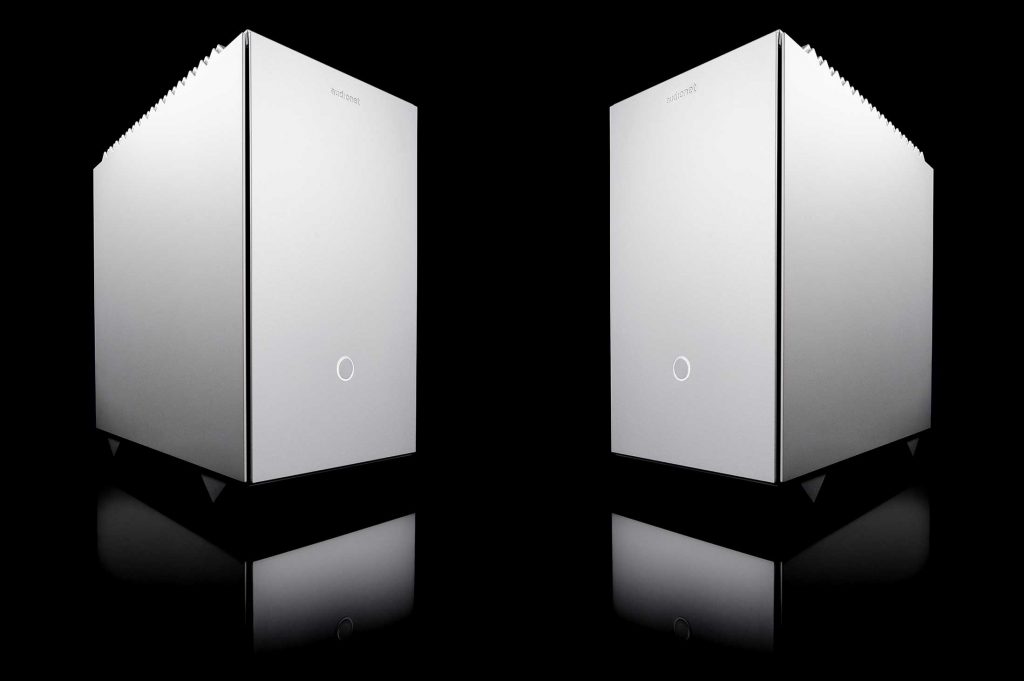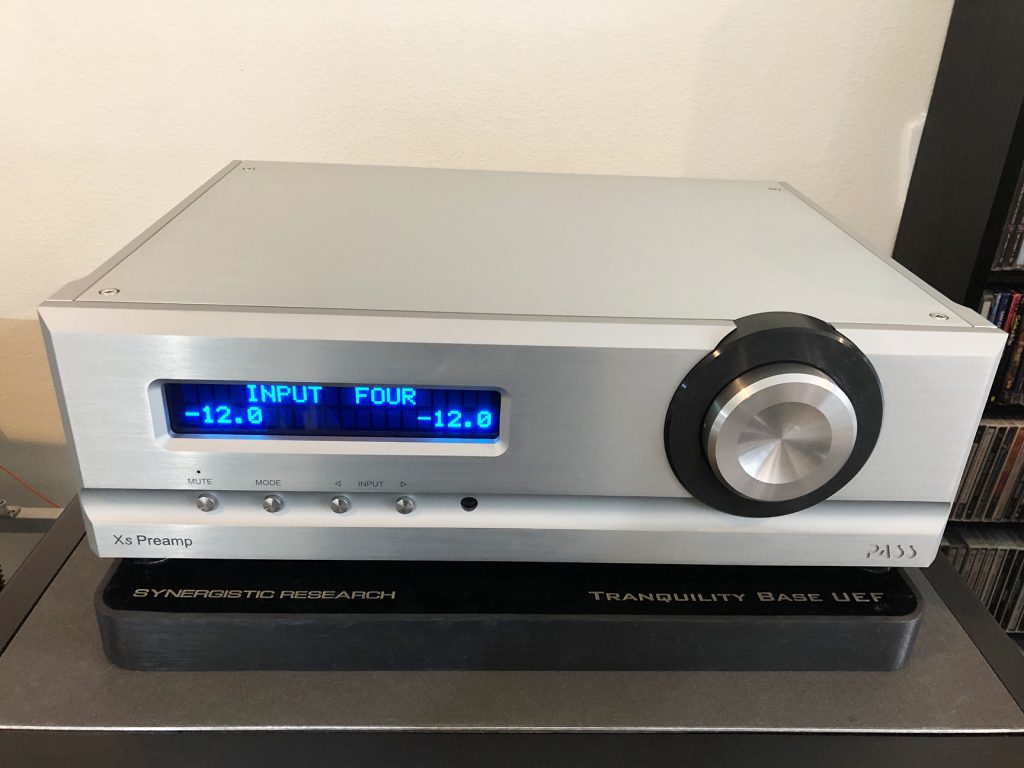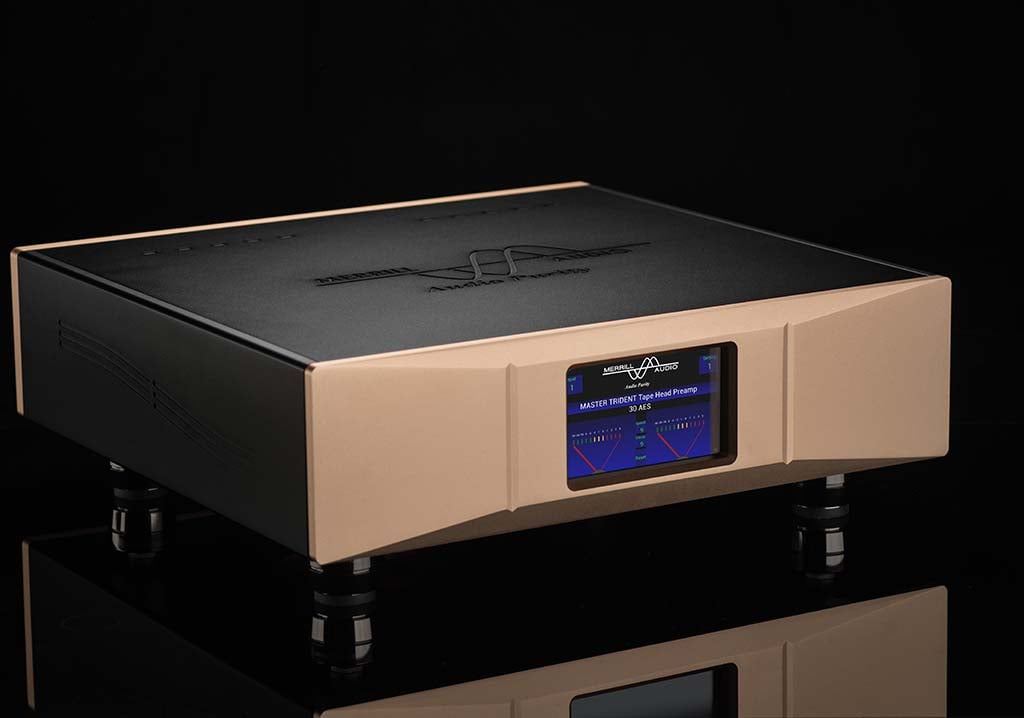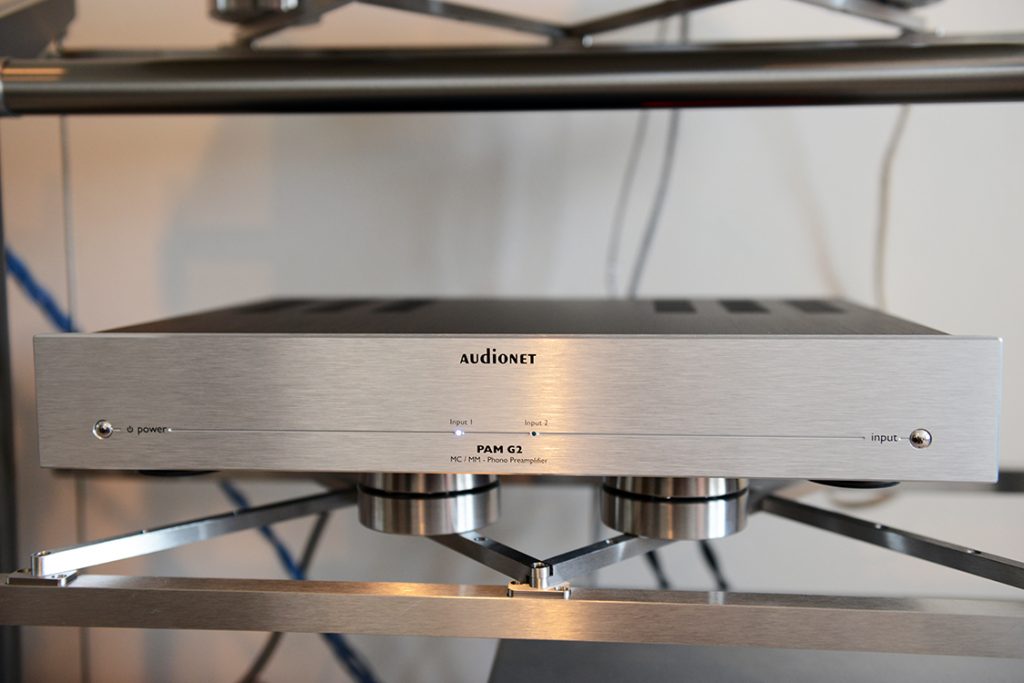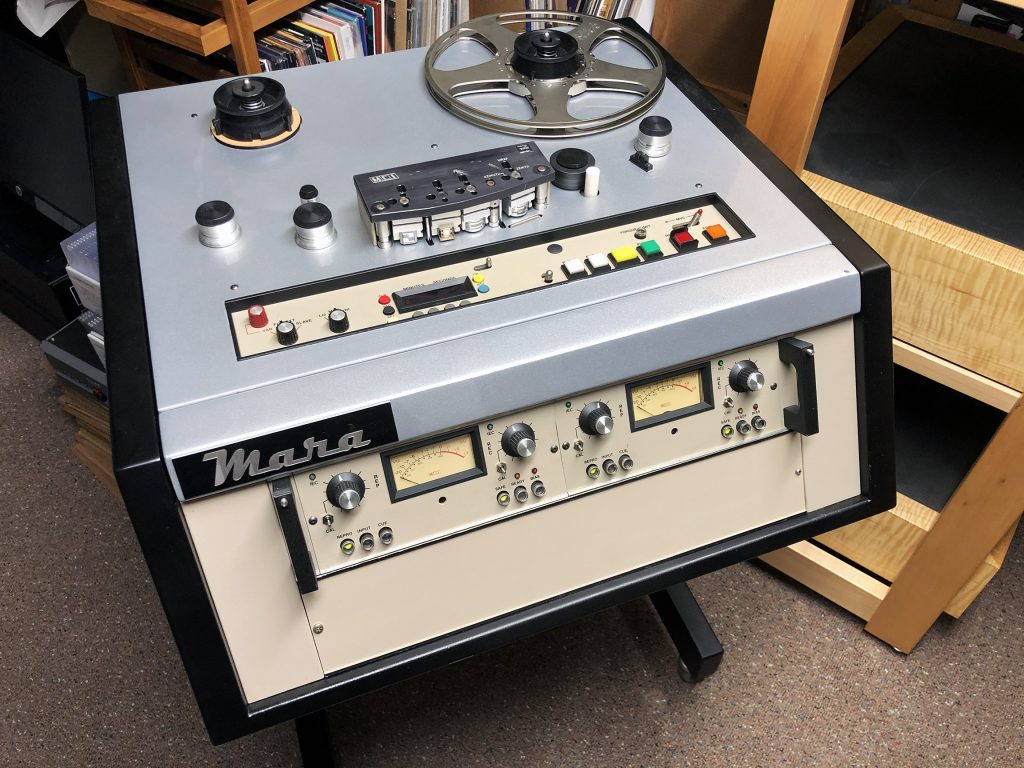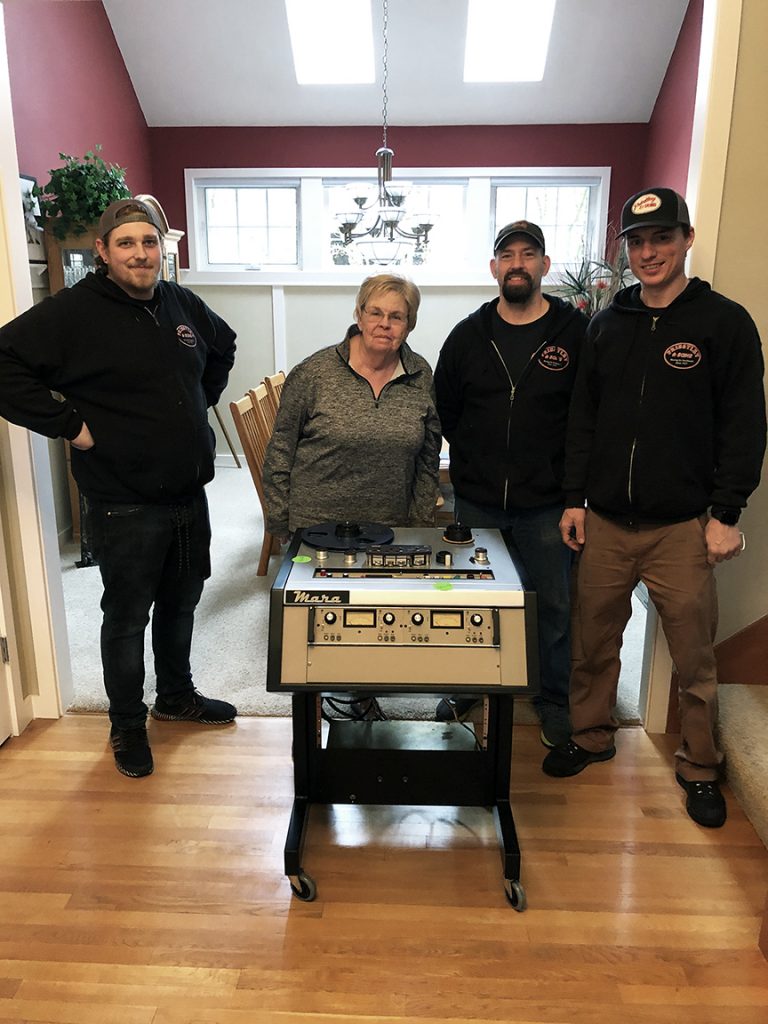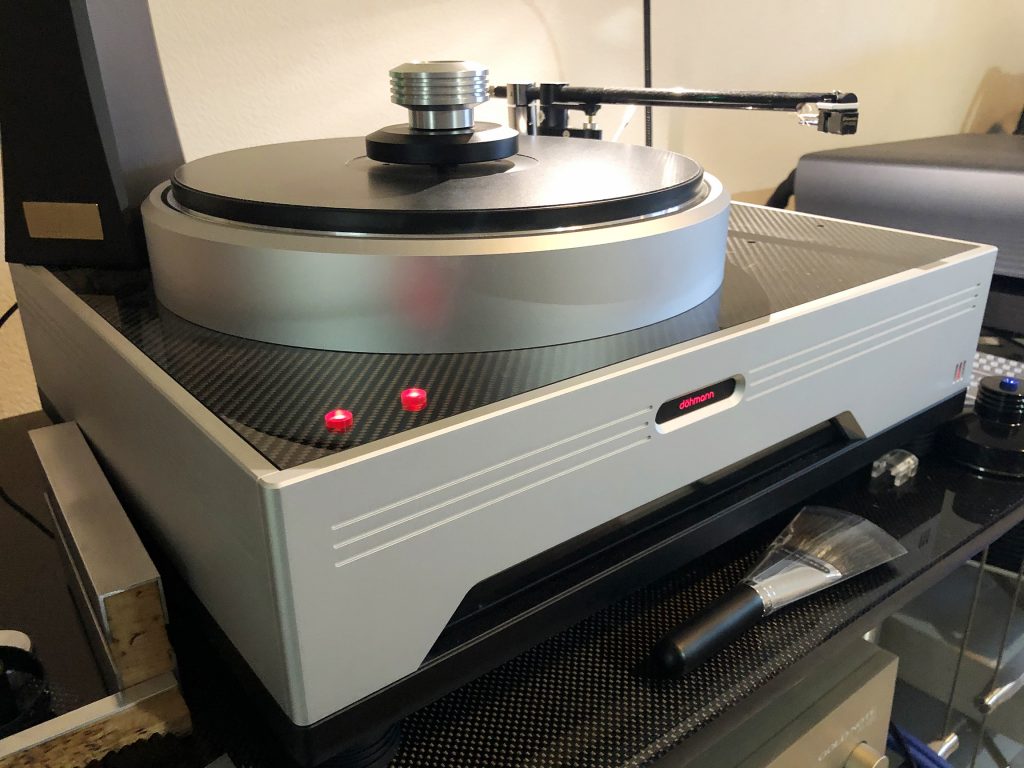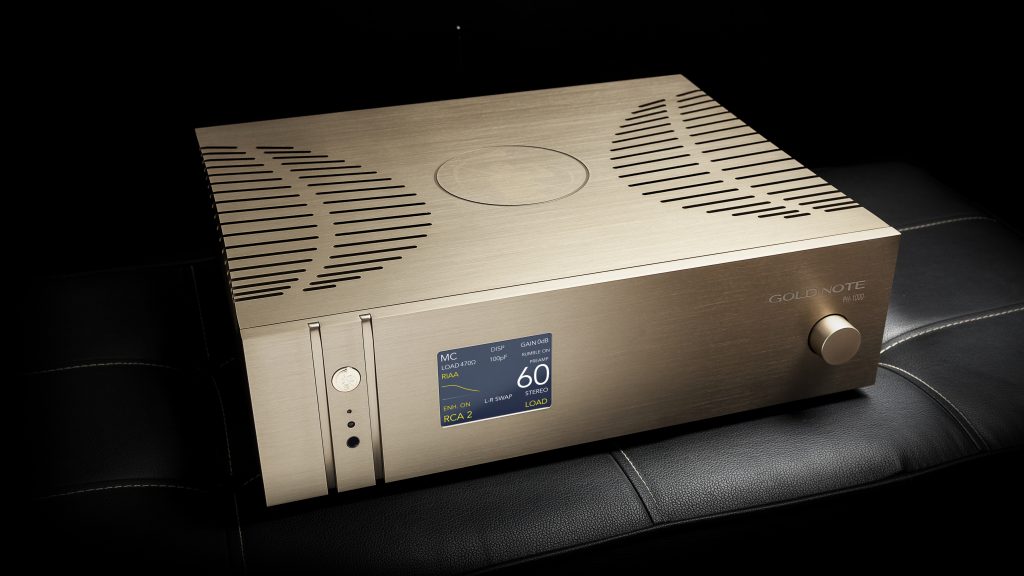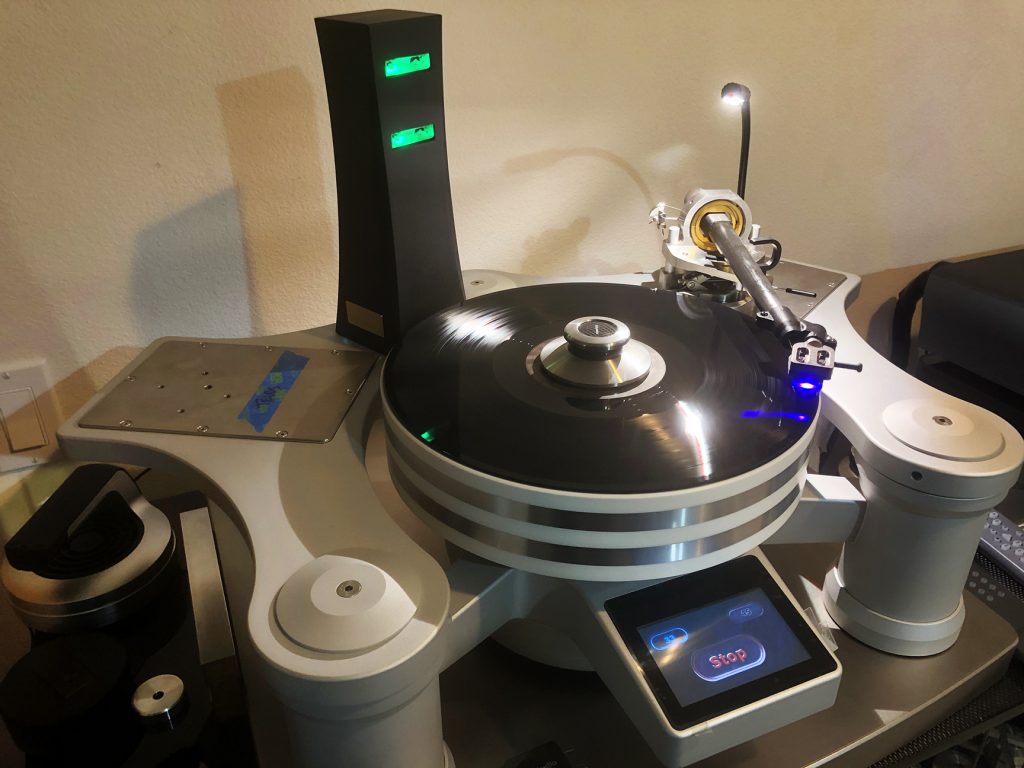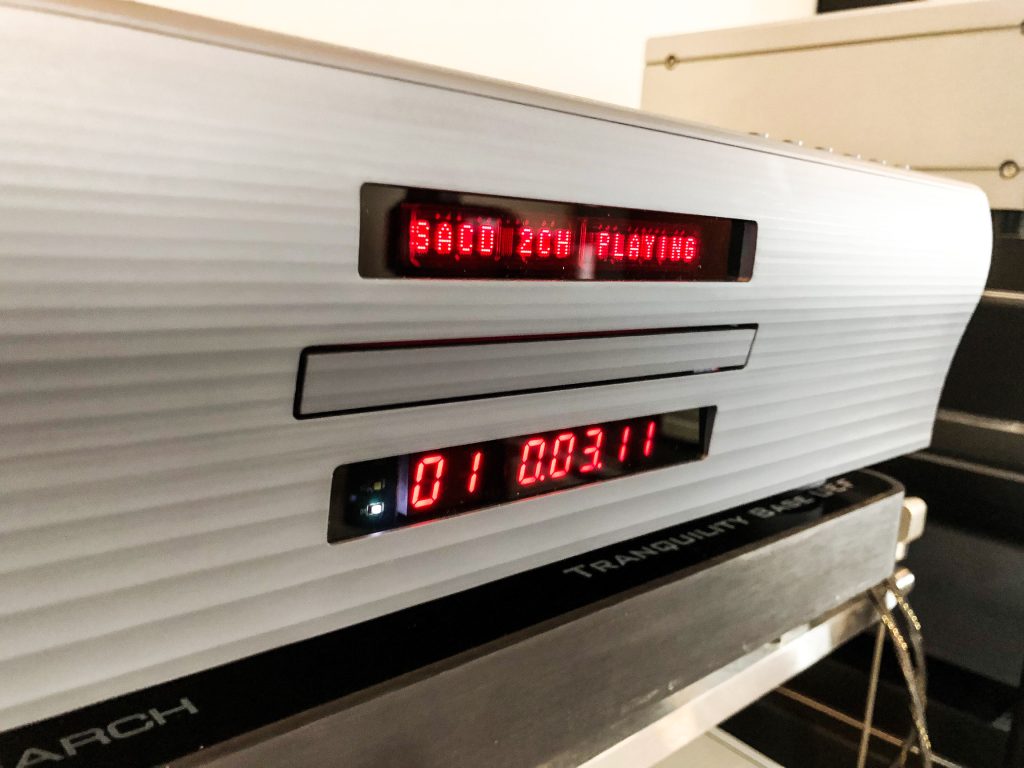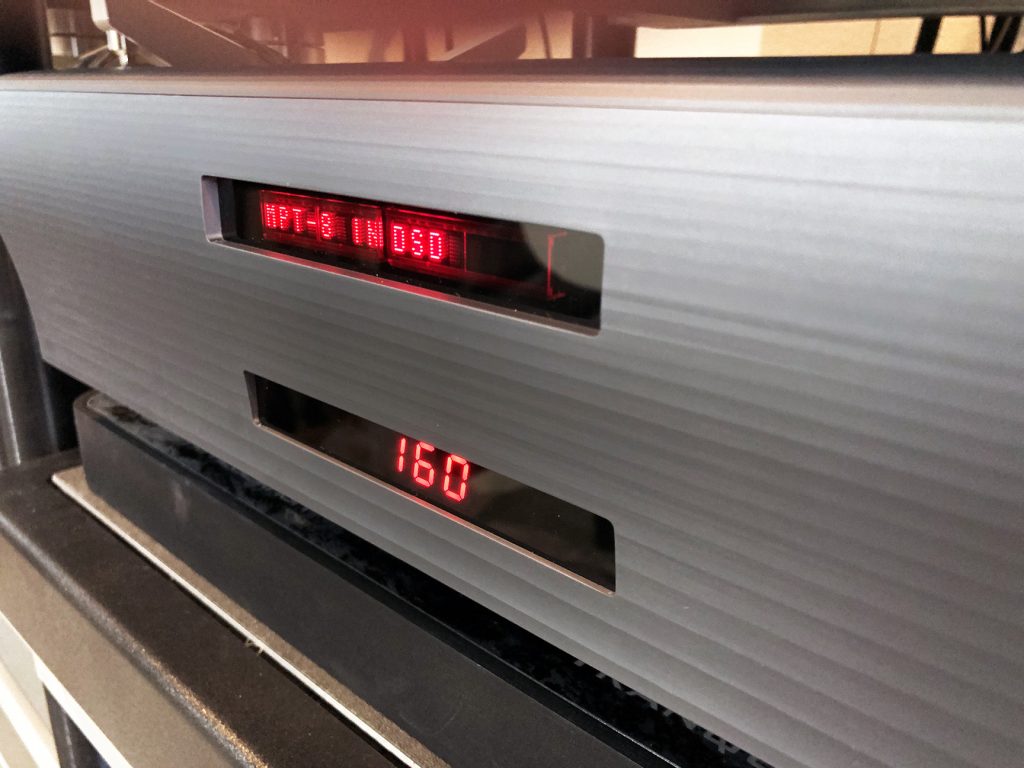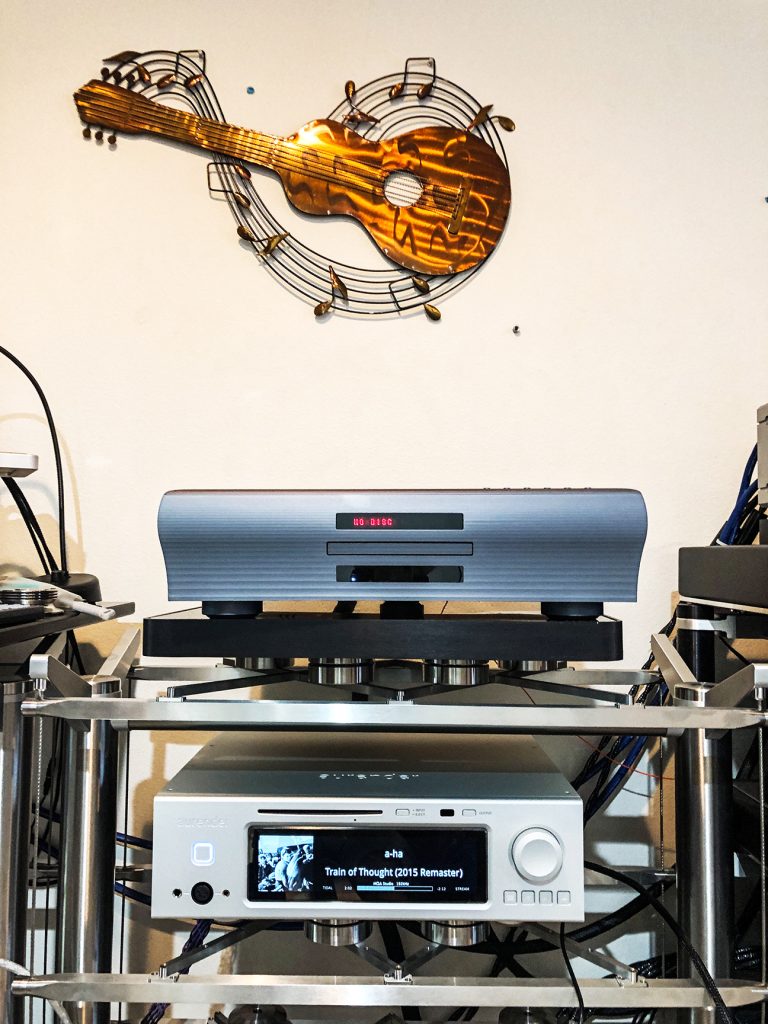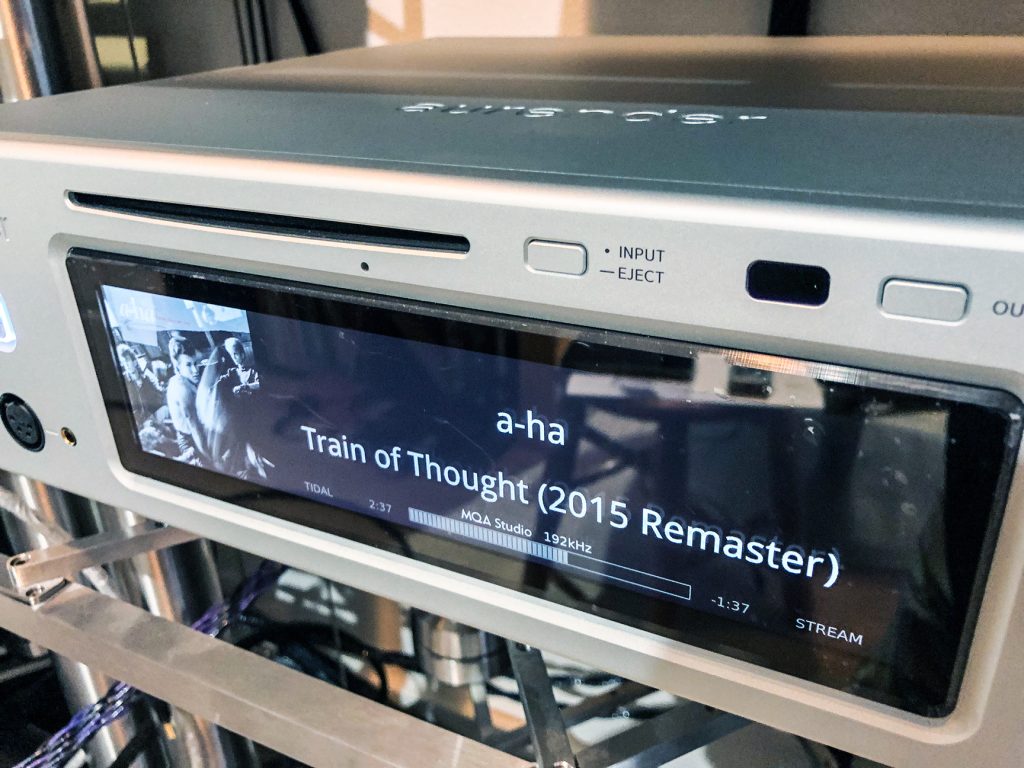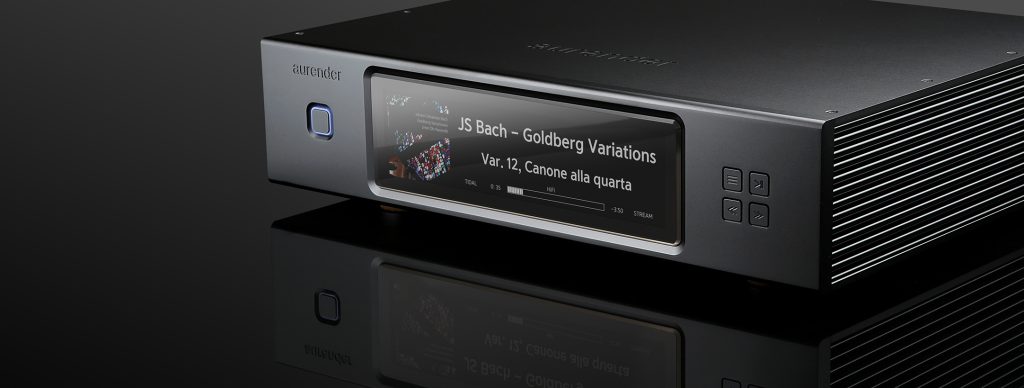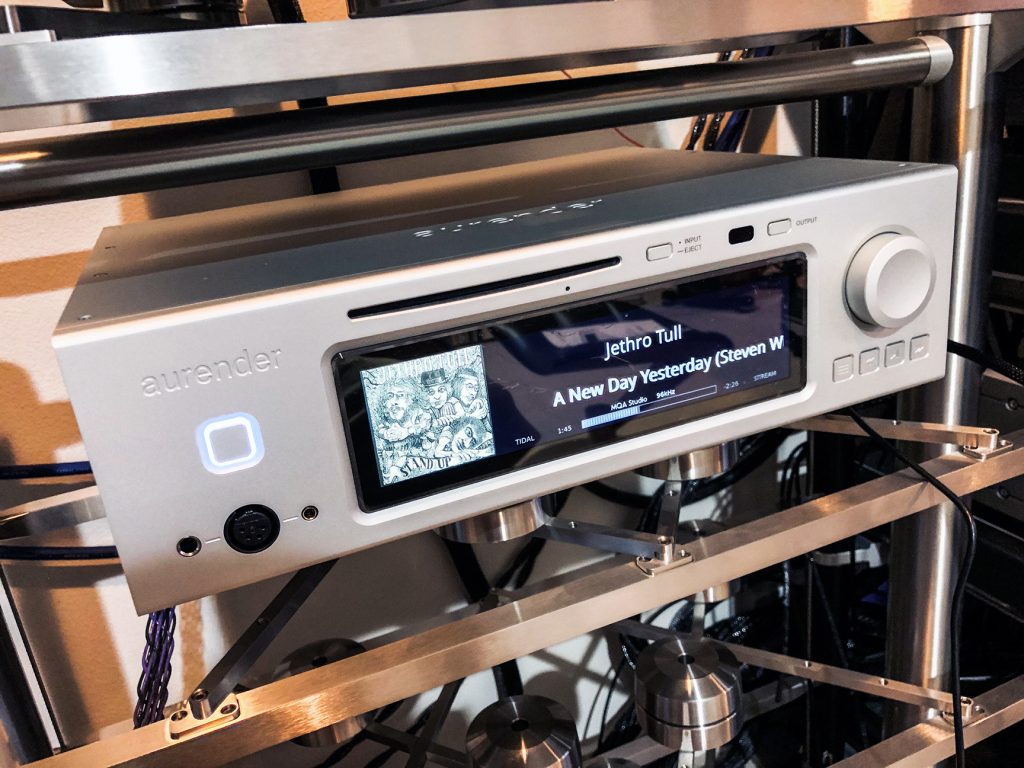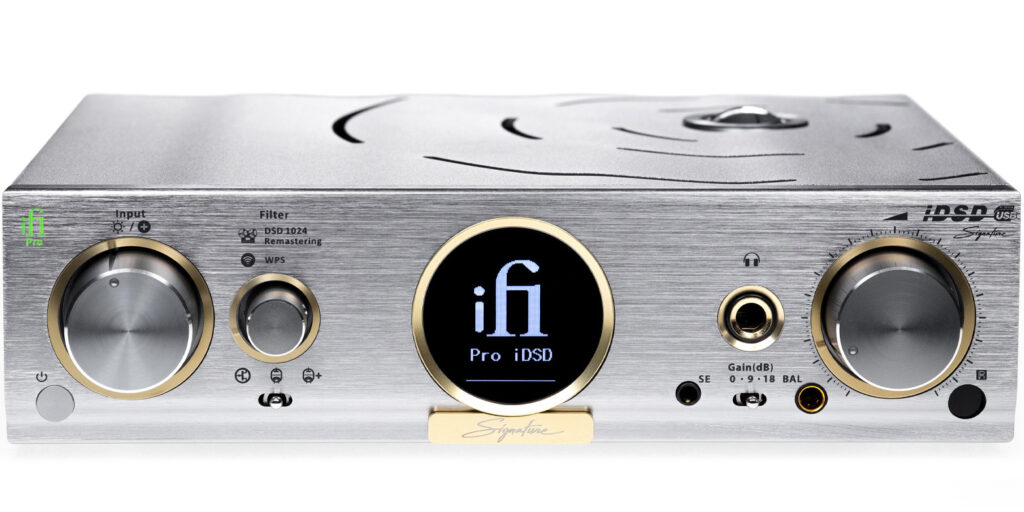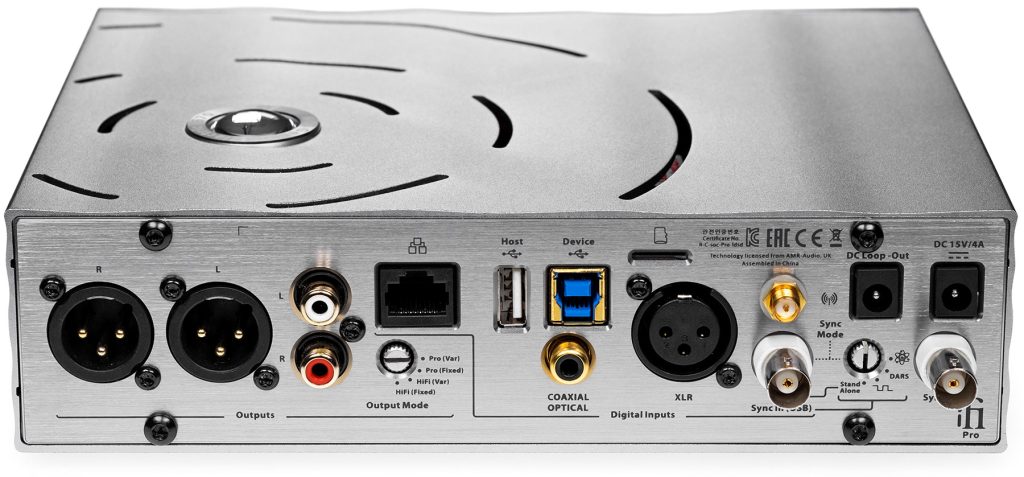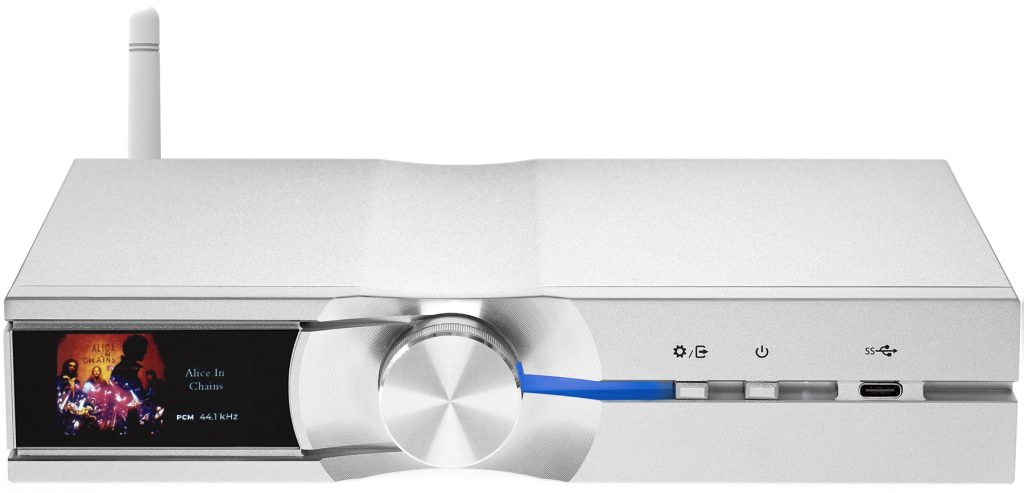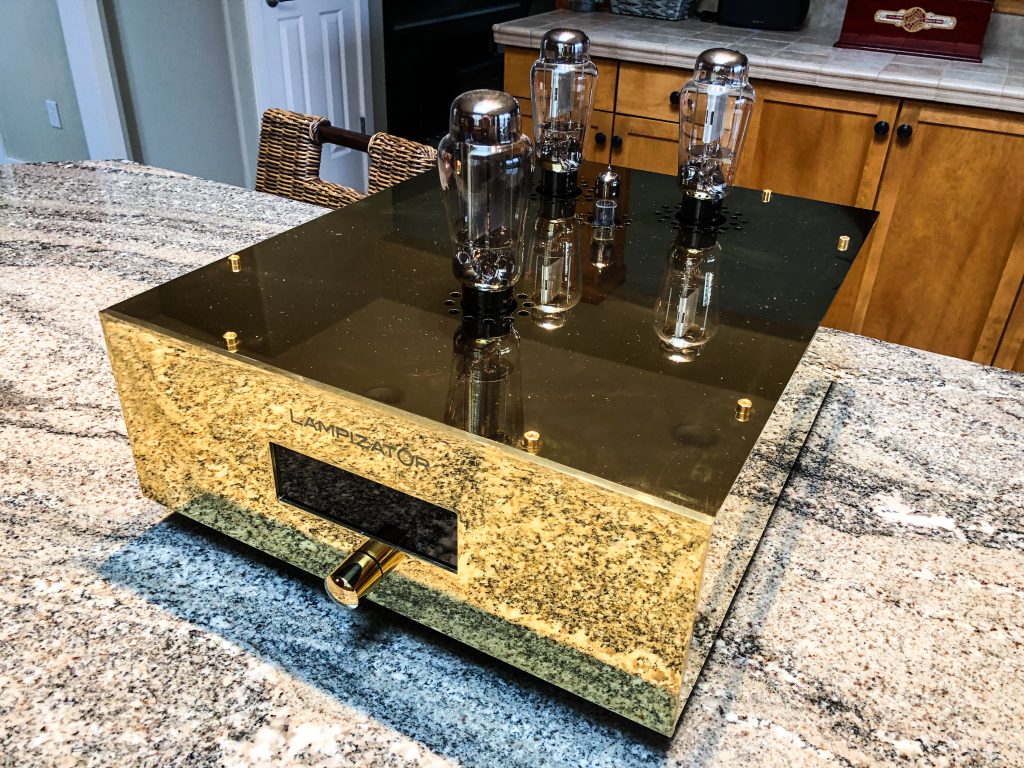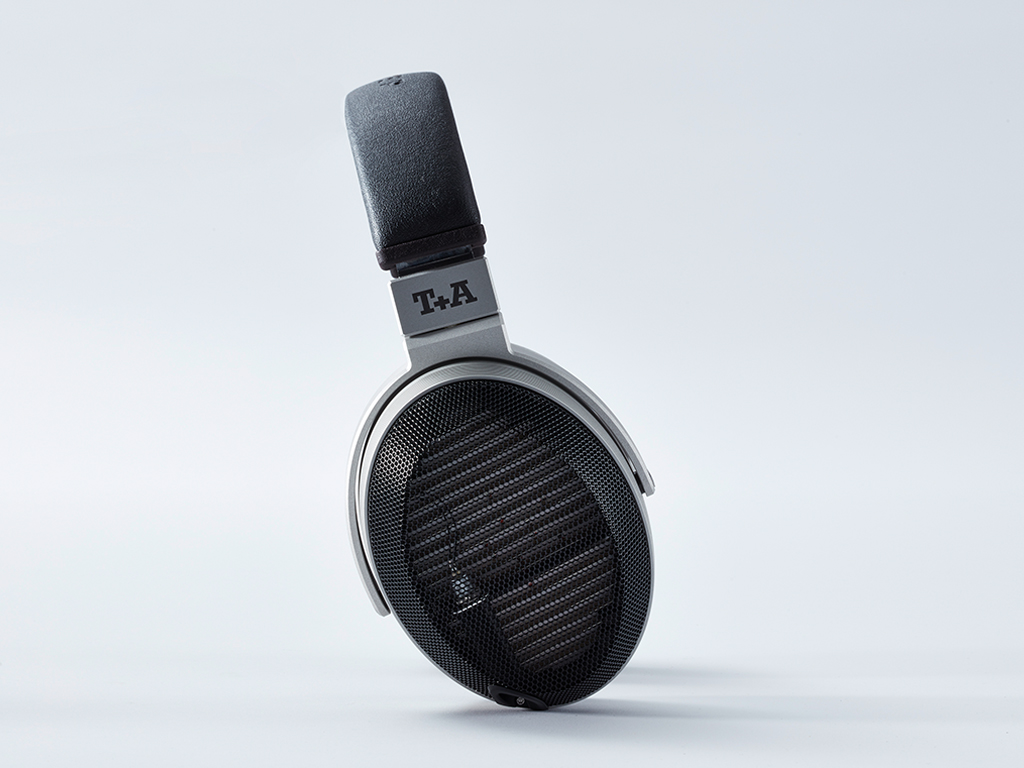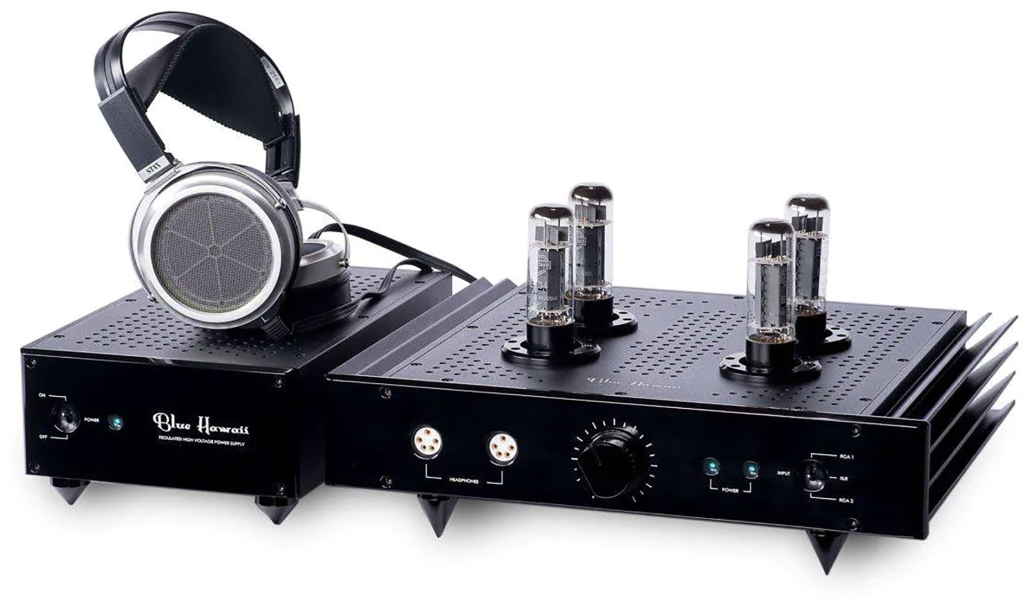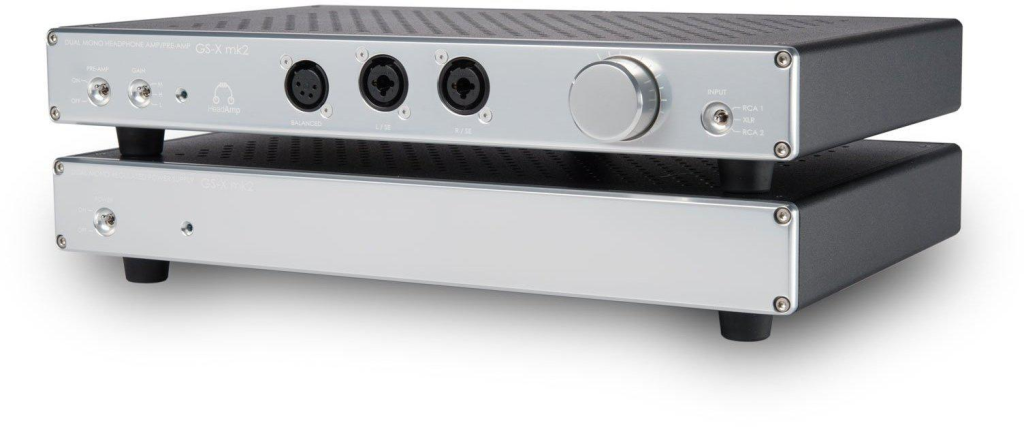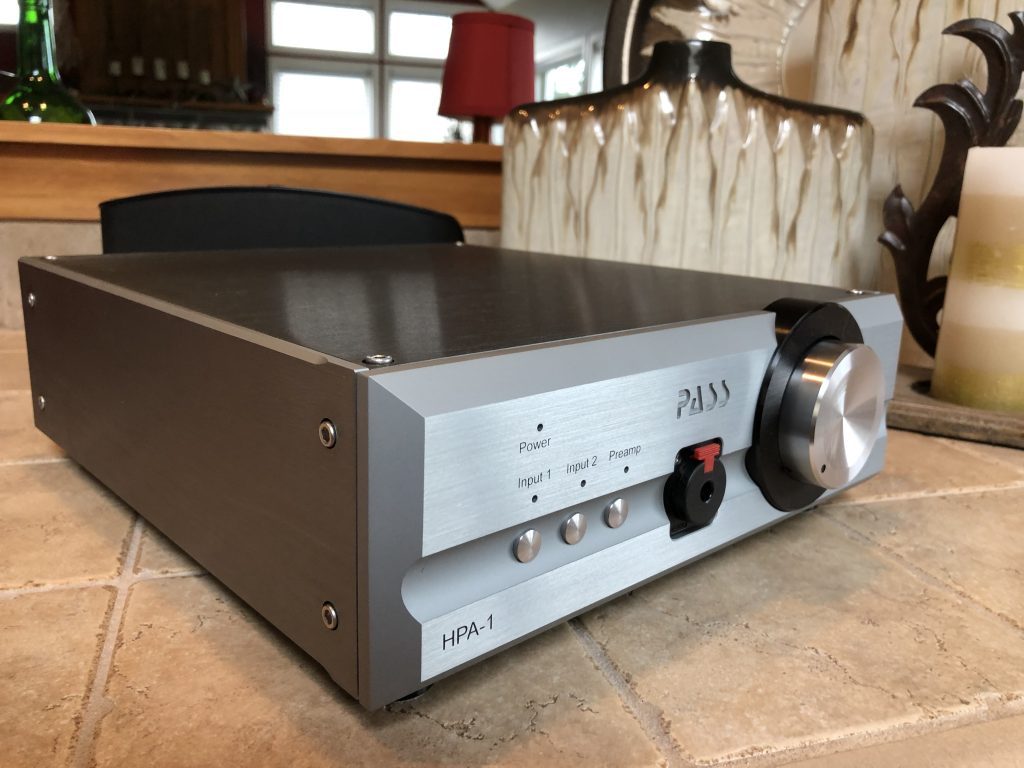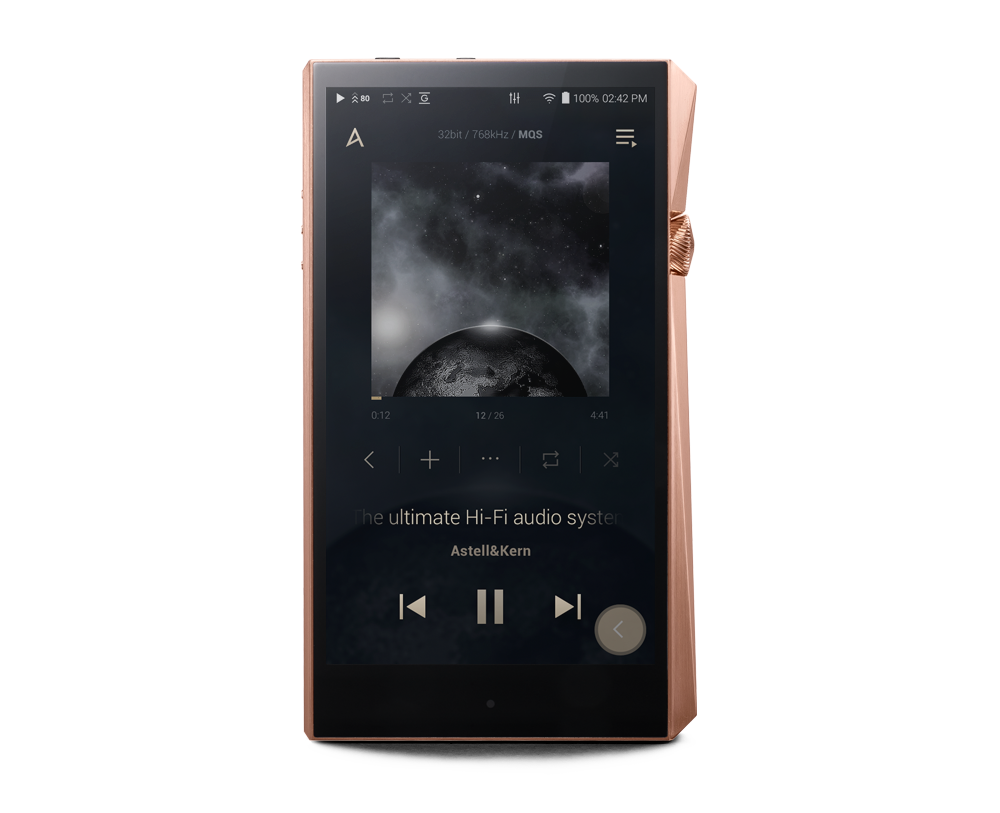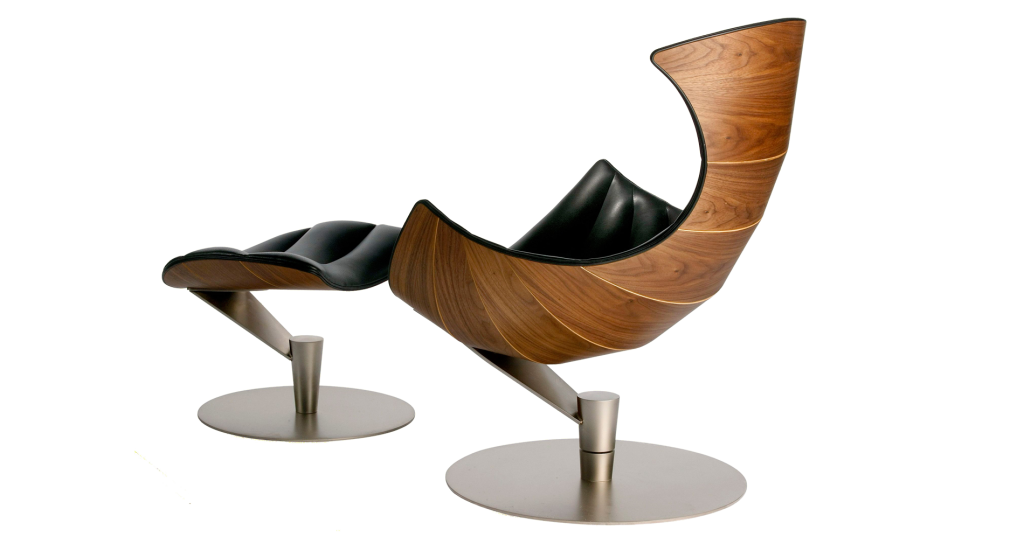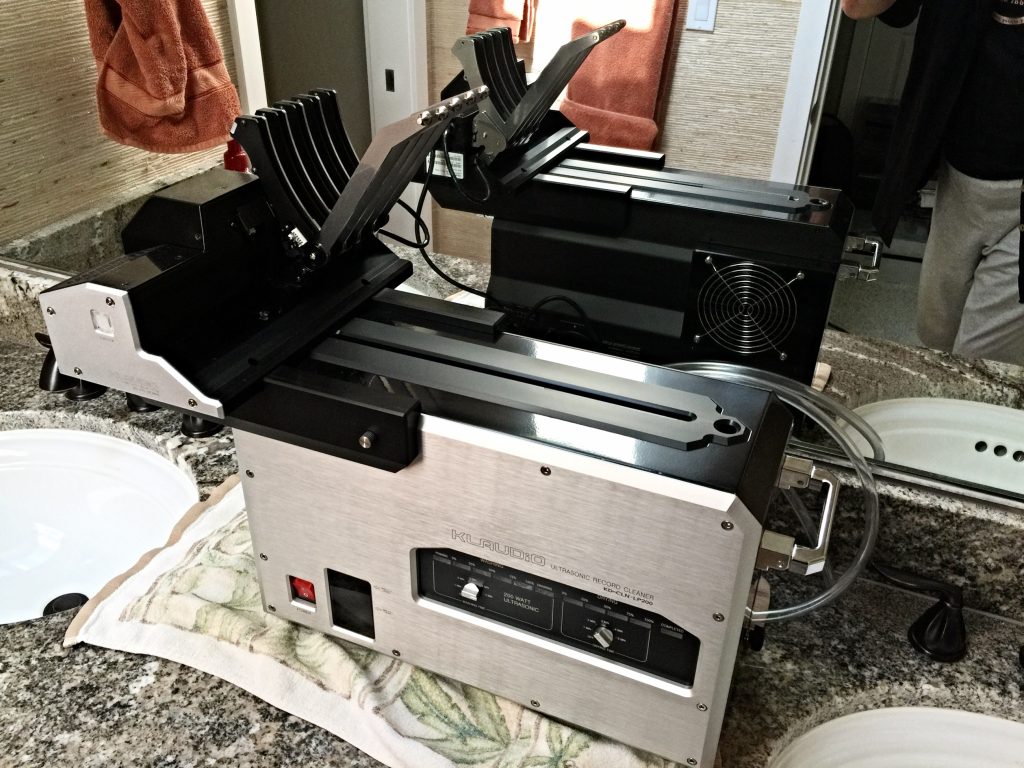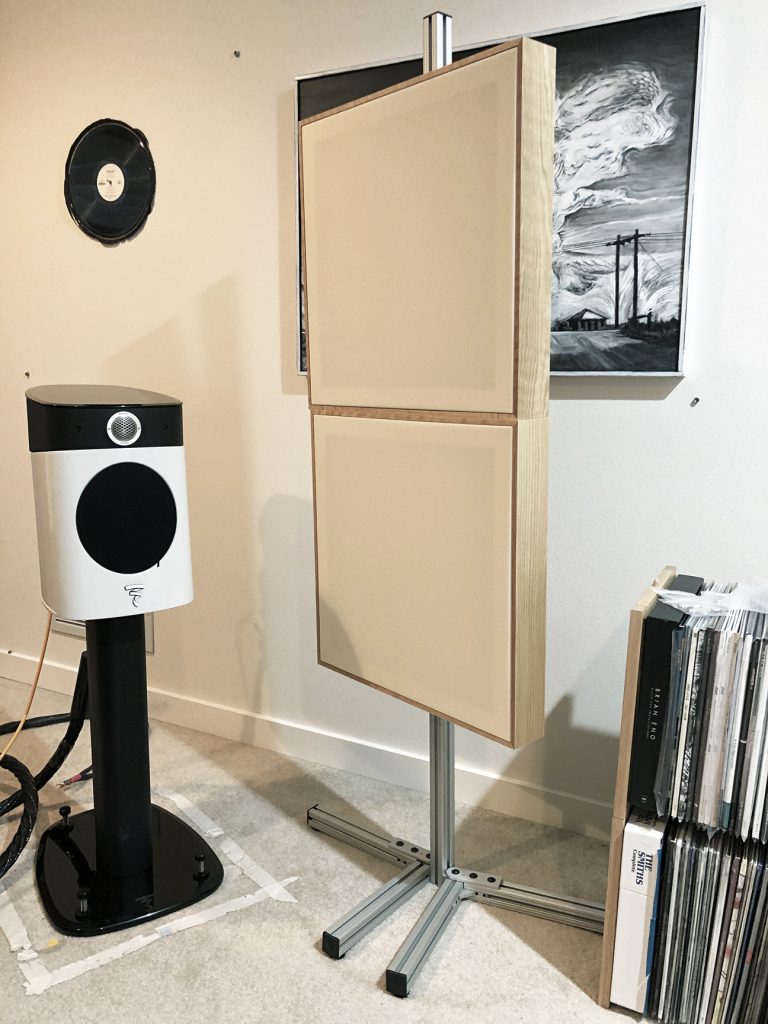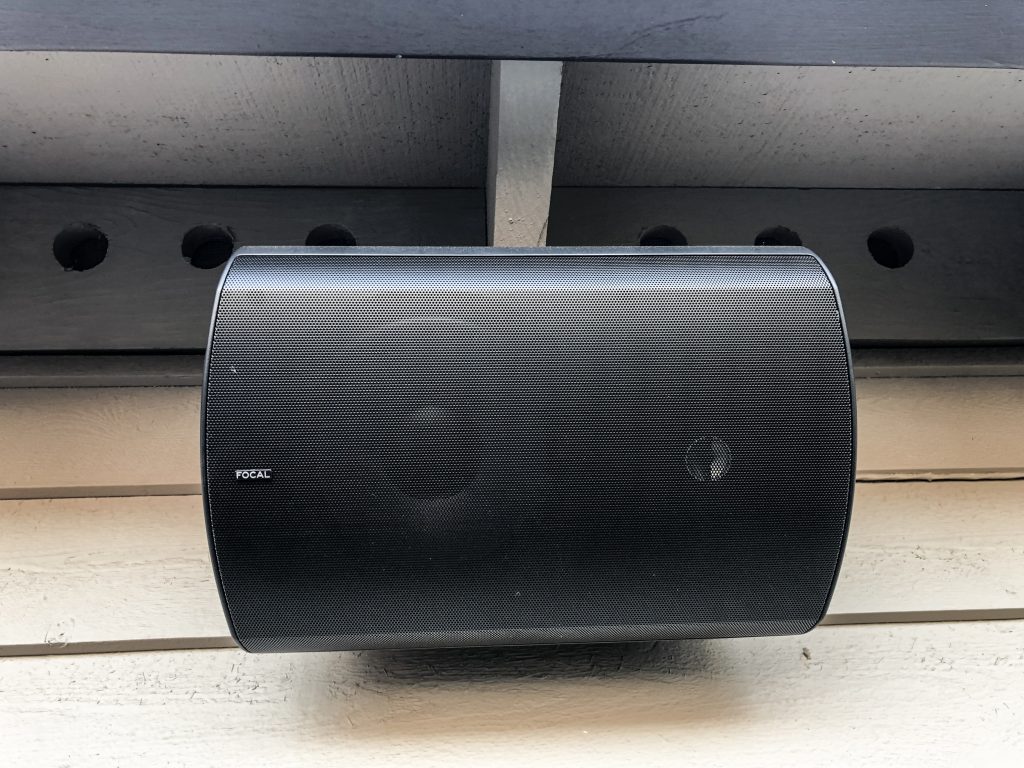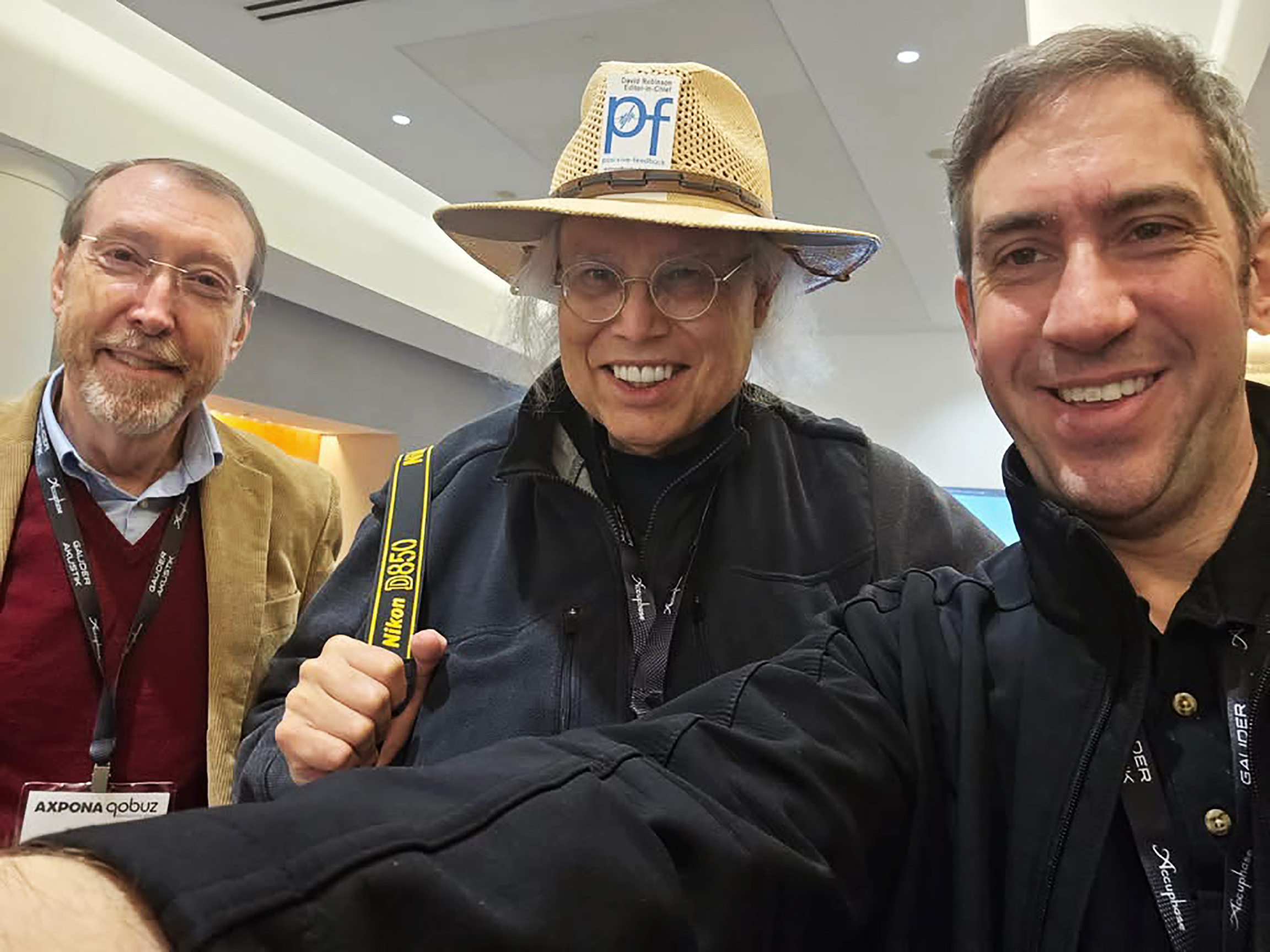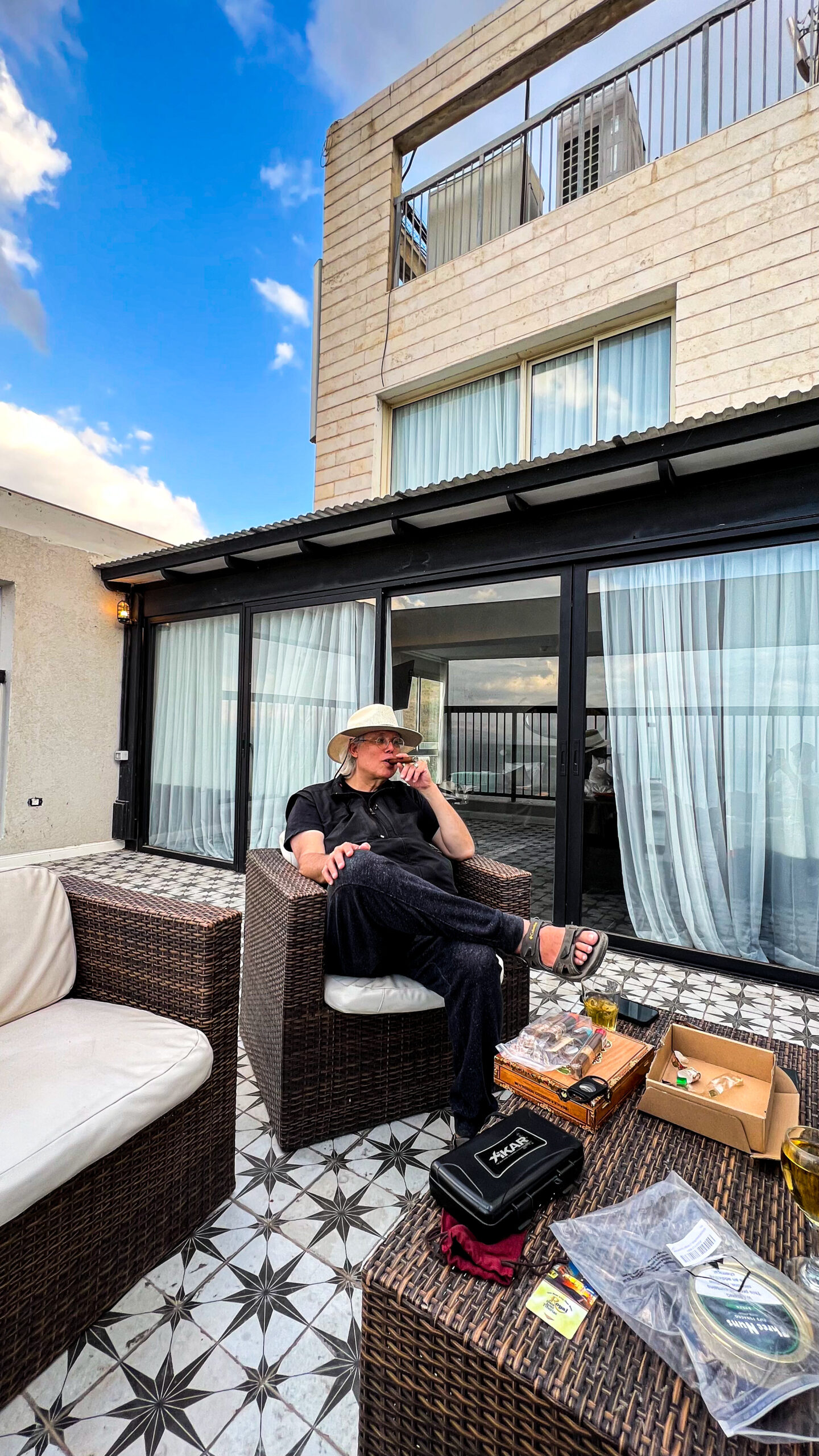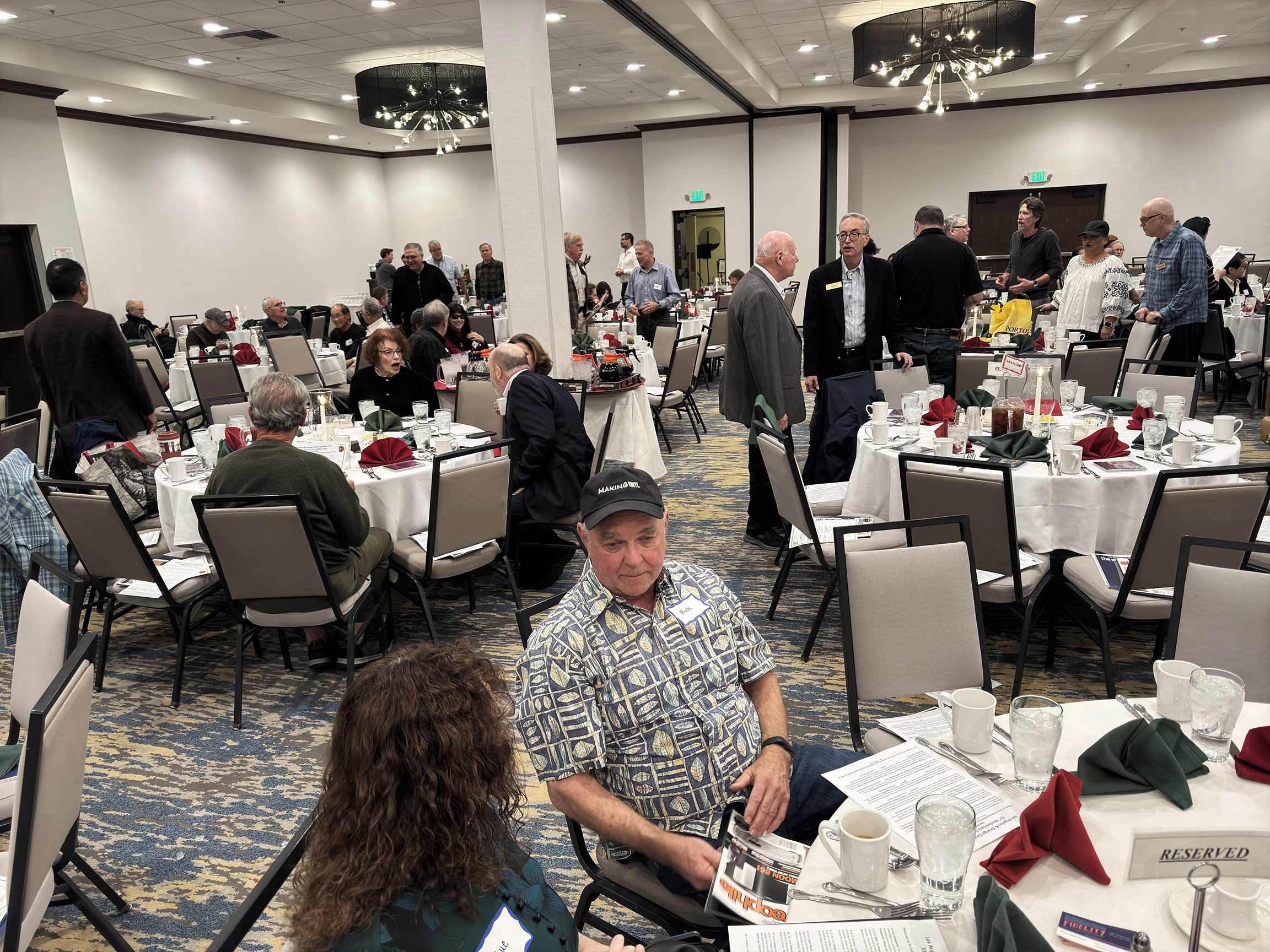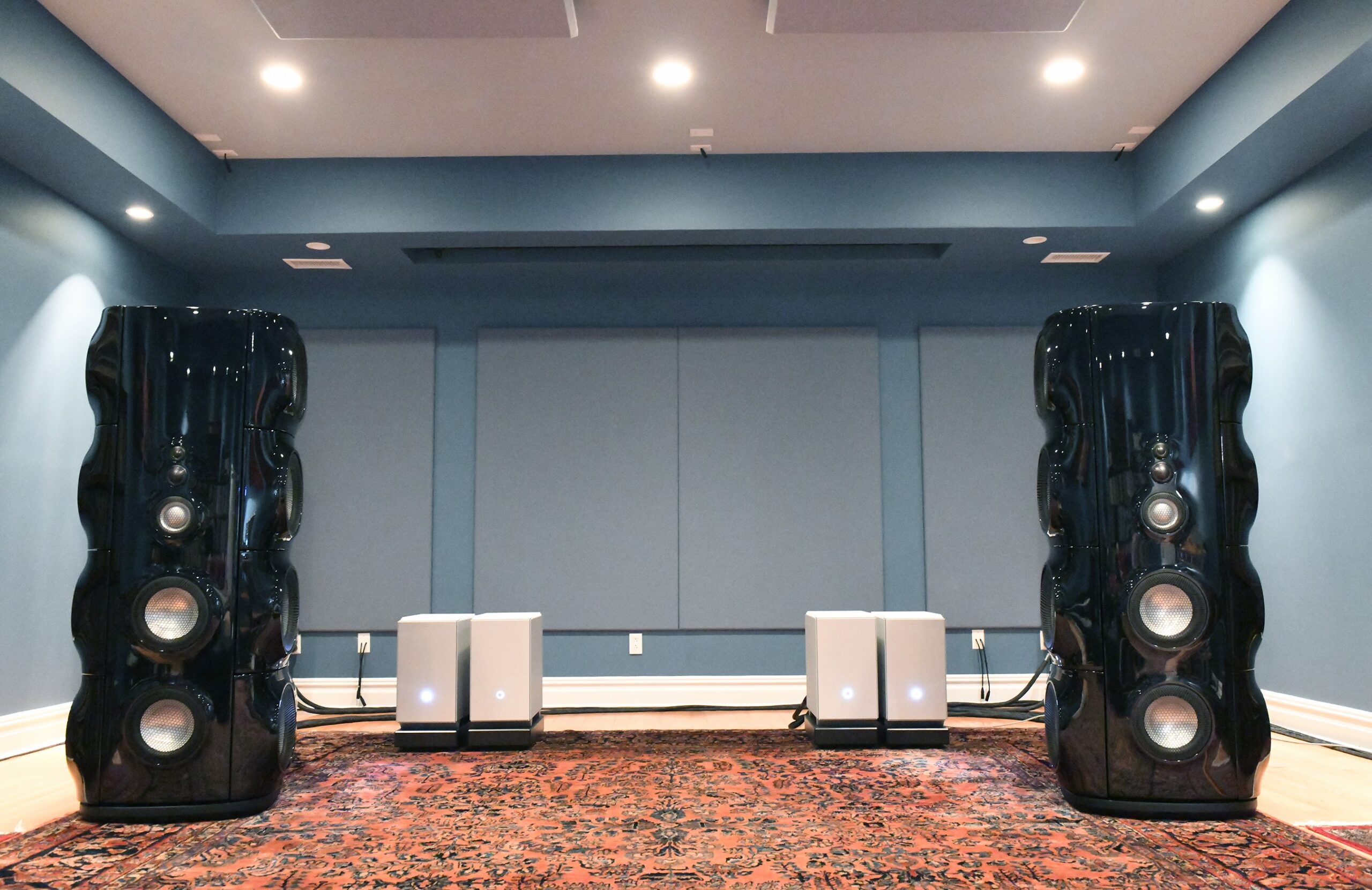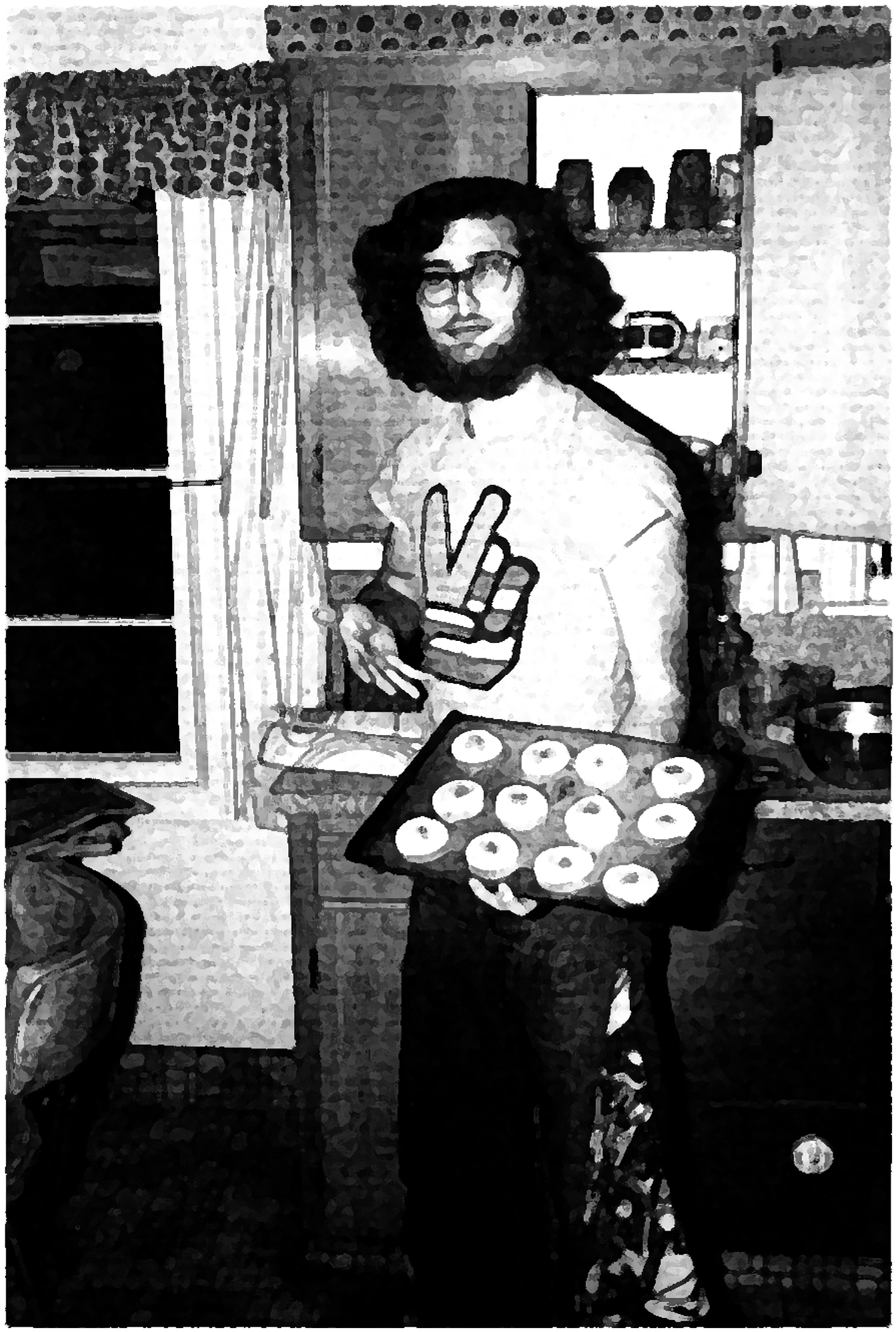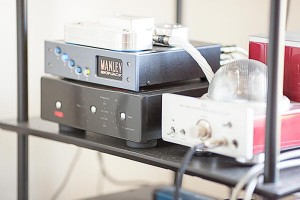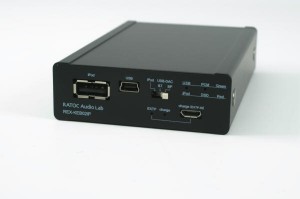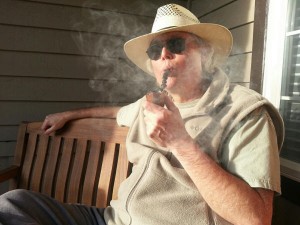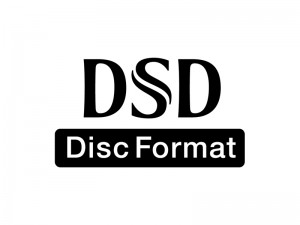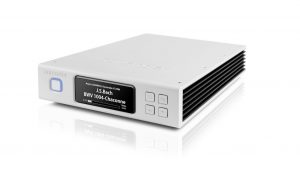So here I am again, returning to one of the touchstone companies for DSD and digital audio: Playback Designs. Am I surprised? Should anyone be surprised?
Heck no.
In fact, according to Andreas Koch, he and I first saw each other at the original DSD demonstration at Mobile Fidelity in Sebastopol, CA, back in September of 1998. There were a lot of key people at that event: Ayataka Nishio, Ed Meitner, Tim de Paravicini, Shawn Britton, John Wood, plus others. (For a reprint of my original paper 'n ink 1998 Positive Feedback report, see Issue 1 HERE.) Andreas tells me that he was there, too; it was a real throng!
The Playback Designs MPS-5 SACD/CD player with Double DSD capabilities via USB-X: a longtime reference for me.
For years Playback Designs was my reference for SACD and DSD, with their MPS-5 SACD player. (DSD was added later, when Andreas developed his intelligent USB-X adapter for USB connectivity.) When the MPS-5 arrived back in the spring of 2008, with its extraordinary FPGA design featuring Andreas' new algorithms, it only took a very short time (seconds?) before I realized that my previous standard for SACD playback, the EMM Labs components, had been bested noticeably. (See my comments all the way back in Issue 39, to see the impression that the MPS-5 made upon me HERE.) I can assure you that not everyone was pleased with my conclusions! But there was no gainsaying the excellence of the MPS-5, and it would have been dishonest of me to say anything other than I did. The addition of Single and Double DSD from computer files after the USB-X arrived heightened the charm of the MPS-5 very significantly; it was a one-stop solution for both optical and computer-based .DFF and .DSF sources.
But time marches on, and the world of DSD digital audio reproduction has been a particularly fertile one in the intervening years. Andreas was a key player in the development of DSD-over-PCM (DoP), an open standard developed by the industry to allow DSD data to be encapsulated within PCM data packets. This was especially important due to changes that Apple introduced in its operating system which disallowed integer mode in audio, and thus DSD, forcing DSD to be transported on Apple computers over PCM. This was a technical challenge that was overcome by a collection of high-end audio firms that collaborated to produce the final DoP specification. As an important participant, Andreas wrote a brief article for Positive Feedback that summarized this elegant solution to the problem, which you can read back in our Issue 60 HERE.
Andreas Koch of Playback Designs: A portrait by David W. Robinson
In that same article, Andreas Koch listed his own impressive background in the field of fine audio and DSD development:
Andreas Koch has been involved in the creation of SACD from the beginning while working at Sony. He was leading a team of engineers designing the world's first multichannel DSD recorder and editor for professional recording (Sonoma workstation), world's first multichannel DSD converters (ADC and DAC), and participated in various standardization committees world-wide for SACD. Later he went on as a consultant to design a number of proprietary DSD processing algorithms for converting PCM to DSD and DSD to PCM, and other technologies for D/A conversion and clock jitter control in DACs. In 2008 he co-founded Playback Designs to bring to market his exceptional experience and know-how in DSD in [the] form of D/A converters and CD/SACD players. Earlier he was part of an engineering team at Studer in Switzerland designing one of the world's first digital tape recorders, then lead a team of engineers working on a multichannel hard disk recorder, and a 3-year stint at Dolby as the company's first digital design engineer, [all of which] gave him a well-rounded foundation of audio know-how and experience.
More changes.
After contributing to the DoP standard, Andreas, along with many other high-end designers, had to deal with the fact that most big companies withdrew from the production of SACD drives, beginning in 2013. In fact, this was paralleled by the fact that the sales of physical media for digital audio have been on the download path for many years now. Downloadable and streaming media have been growing powerfully for a number of years now, and the definite market trend, even in high-end audio, is pretty clear.
Additionally, DSD as the ultimate format for digital audio, continued to blossom beyond Single, or even Double, DSD, and now has the Quad DSD (256fs) standard which has emerged as the no-holds-barred capstone…at least at the current time. Octo Quad (512fs) is already available, however, and is being used by companies like Sound Galleries as an undecimation-and-oversampling approach in its Monaco Music Server. (This is in conjunction with Octo Quad DSD DACs like the T+A.) Merging Technologies was the key player in shaping this movement, since their pro-grade Quad-DSD capable Horus and Hapi analog-to-digital converters (ADC) and their NADAC digital-to-analog converters (DAC) upped the game significantly, and made recording, producing, and listening to Quad DSD a real and powerful option. Staying with the maximum of Double DSD risked being left behind by an even higher resolution that has a definite market presence in high-end audio…NativeDSD.com, SuperHirez.com, High Definition Tape Transfers, and Blue Coast Records all offer quite a number of Quad DSD downloads right now.
This led Playback Designs to shift ground away from its heretofore heavier reliance on optical media, and towards the creation of a new series of D/A converters that would emphasize computer-based audio. The first generation of this development was in the MPD-3 and MPD-5 DACs, which were models that I never heard.
I did, however, get a sense of the shape of things to come when Andreas shipped me his newly redesigned IPS-3 in 2015. This was a 130 WPC/8 ohm integrated amp with a fine preamp and an integrated DAC. There was a combination new software, and also some new hardware to handle the updates to the firmware. Why was that? Because, lo and behold, this new version's DAC was now an FPGA Quad DSD DAC! Playback Designs had managed what some other designers couldn't do without resort to an off-the-shelf chipset: Ramp up an FPGA design to handle Quad DSD with aplomb.
As a matter of fact, I helped Andreas by evaluating the initial firmware run. We have many Quad DSD recordings in the PF library of recordings here, and I was able to toss tons of music from all categories at the IPS-3. My initial response led him to tweak the software a bit; the second pass was a home run. At that point, it was impossible for me to do anything other than love the IPS-3, a true mighty-mite of fine audio. Here it stays.
But that was just a harbinger of what was to come from Playback Designs.
Andreas contacted me early in 2016, and asked if I would be attending AXPONA 2016. He had hinted to me earlier that he had some very significant developments in the works. I told him that I would be in Chicago, for sure. He then said that he would be introducing his new Sonoma line, a radically new and improved set of digital components that would set the benchmark for digital excellence much higher.
At that point, if I had not been planning on going to AXPONA, I would have likely changed my mind. (Well, maybe not; I really do hate O'Hare Airport quite a lot.) When Andreas says that he has a great new design coming out, I've learned to pay attention. Exclamation point. You should, too.
AXPONA is a show that I've attended over the past couple of years. It's become a strong event, with significant turnout…about 5000 in 2016. It certainly looked like it, as I reported in my two-part essay, HERE and over THERE.
While there, I spent some significant time with Andreas Koch and the new Playback Designs Sonoma stack.
Andreas Koch with his new Sonoma stack at AXPONA 2016. On the top shelf is the Merlot Quad DSD DAC; next down is the Pinot Quad DSD ADC. On the third shelf is the Syrah Quad DSD Music Server, sitting on top of the Oppo Digital BDP-103 with OpBox direct-from-the-heads electrical-to-optical converter, with its PLink optical feed to the Merlot DAC. On the bottom shelf is the Playback Designs IPS-3 Integrated Amp with Quad DSD DAC, acting entirely in the analog domain.
I also got to see some other members of the DSD fraternity who were in attendance there…
Michael Bishop of Five/Four Productions, who was mightily impressed with the Playback Designs Sonoma stack. Me too!
Brian Tucker of Pro Audio in Chicago, with his Revox providing RTR action in the Playback Designs room, AXPONA 2016. The sound of the Quad DSD transfers from the Revox was simply smashing!
Andreas Koch and Bruce Brown of Puget Sound Studios in the Playback Designs room with the Sonoma stack and the IPS-3 Integrated Amp with DSD DAC, AXPONA 2016.
Members of the DSD Brain Trust in action: Andreas Koch and Michael Bishop debugging a DSD feed at AXPONA 2016.
My initial impression of the Pinot ADC was that Andreas had accomplished a spectacular achievement: a sub-$10K Quad DSD stereo analog-to-digital converter with easy-to-use software for simple stereo transfers from analog to DSD (in .DFF format). And it sounded brilliant! Show conditions at AXPONA 2016, of course, but even allowing for that, the Pinot was clearly something very special, working in tandem with the rest of the Playback Designs Sonoma stack.
In fact, Andreas not only gave us quick A/B comparisons of analog source (turntable and Brian Tucker's Revox RTR) vs. Quad DSD output…all of which were very impressive…but he also did a single blind test just before the end of the show. Several of us who were very experienced, acute listeners, were invited into the Playback Designs room. Andreas did switching back and forth between an analog source and the output of the Pinot Quad DSD feed. We were given several opportunities to guess which was which.
The three of us who were invited to do so guessed wrong. We thought that the Quad DSD feed was actually the analog source! One therefore wonders: Does the Pinot's Quad DSD sound better than the analog source?!
Amazing!
Regardless, the upshot of my experience with the Sonoma stack at AXPONA 2016 immediately convinced me (as if I didn't suspect this going in) that the Playback Designs stack was a system that I needed to review ASAP. Andreas cordially agreed to bring it in just as soon as the first production run was completed. Done deal!
As good as his word, Andreas arrived here at Positive Feedback Central in late May, just before THE Show Newport Beach. He had all three of the Sonoma stack units with him, but the Pinot ADC would have to leave with him, as production of that model had not yet started. (They are available now, however.)
Andreas and Heidi Koch at the Stone Cliff Inn Restaurant during their visit to deliver the Playback Merlot and Syrah units.
I had already received the Oppo Digital BDP-103 with the Playback Designs OpBox optical converter prior to Andreas' arrival. In the interim, I had been using it as an optical transport with his IPS-3, using the PLink connector and ST Glass cabling to connect the two. The results had been excellent; the new Quad DSD-capable IPS-3 had handled the feed from the OpBox with ease, and had provided a pretty astonishing level of performance in our desktop reference system (nearfield listening).
The Playback Designs Sonoma stack (minus the Pinot ADC at this point): From the top, the Merlot Quad DSD DAC, the Syrah Quad DSD Music Server, and the Oppo BDP-103 with OpBox optical output converter. The components are resting on the Stillpoints ESS Reference Rack with Grid Shelves and Ultra V Isolation Feet.
Now we were able to shift the Oppo OpBox to the main stereo listening room, and PLink it to the Merlot Quad DSD DAC. The Syrah Music Server is connected to the Merlot via USB. Since this is a true reference-grade configuration, I have used both the Kubala-Sosna Realization USB Cable, and the Skogrand Beethoven USB Cable. Both are world class, and well up to the task of getting the most out of the Sonoma stack.
The Playback Designs stack (minus the Pinot), in SACD mode from the OpBox in the BDP-103. Beneath is the GamuT Audio D3i dual mono reference preamp, a very fine piece of work, and now departed, sadly….
Once Andreas and I had the three components connected, we then hooked them up to the GamuT Audio D3i reference preamp via Kubala-Sosna Elation! unbalanced cable. That provided us with the base system that would remain after Andreas left.
Since the Pinot ADC was only going to be there for the afternoon, we did a temporary connection to one of our LP systems so that we could do some sample Quad DSD transfers of needle drops that we would do. We used the exceptional KRONOS Pro Turntable for this task. Its output was cabled with Kubala-Sosna Elation! unbalanced cables to our standard reference, the Audionet PAM G2 Phono Amp with EPX Power Supply. That output went to the Audionet PRE G2 reference preamp, which passed the output via its balanced monitor outs to the balanced inputs of the Pinot ADC. Andreas' notebook computer with his Sonoma Recorder software, a very compact, easy-to-use recording system, was also connected to the Pinot. This allowed us to do several needle drops and listen to them, while the notebook recorded those drops to DSD .DFF format.
Those transfers turned out incredibly well. A quick listen to the results, before the Pinot had to be packed up again, indicated that the Quad DSD transfers were indistinguishable from the KRONOS playback that Andreas and I had just heard. One was the opening track from Dream with Dean on Analogue Products QRP 200 gram vinyl; then we did a sample track from the brilliant reissue of the Decca Espana with Atualfo Argenta (incredible album and transfer!), and finally three tracks from the excellent recent reissue of the MPS LP How I Really Play by Oscar Peterson. Really breathtaking, believe me.
The full-time Pinot Quad DSD ADC just arrived the other day. It will take time to appraise it on a longer term basis. Until then, the above will have to do. The Pinot certainly seems to be an exceptional achievement thus far.
The Sonoma stack: A digression on a systems approach to digital sound
System diagram: The Playback Designs Sonoma System (image courtesy of Playback Designs)
The Sonoma stack is a complete system for dealing with digital audio in the home. As the diagram above illustrates, Andreas and company have envisioned a wall-to-wall approach. The Merlot DAC will act as the center of an array of Playback Designs sources: The Pinot ADC, the Syrah Music Server, and the OpBox optical player. With a supporting computer for handling the recordings, and an iPad for the Playback Designs Syrah Music Server control interface, you have a very powerful system for handling music of all formats. This includes the ability to interface with your LAN to locate and use music that is on your network. I like the comprehensiveness of the Playback Designs vision: This is the way to approach high-resolution audio…with intelligence and interoperability.
Turning my attention to the Merlot DSD DAC and Syrah Music Server…
…these I can comment on based on a few months of operation here.
The Merlot Quad DSD DAC (image courtesy of Playback Designs)
The Merlot Quad DSD DAC is actually more than that. Playback Designs has also added a headphone amp to the circuitry, with a standard 6.5 mm stereo jack in the front, and its own dedicated volume control. This is a very handy touch, and a tip o' the hat to the personal fi/headphone folks.
Among its features:
- Up to 384kHz PCM and up to 11.2MHz DSD, stereo
- USB, AES, Coax, and PLink inputs
- Balanced and unbalanced line level outputs
- Differential discrete DAC
- Software upgradeable by end user
- Sonoma recording software for file creation on computer
I find that the Merlot has shown itself to be a worthy successor to the earlier MPS-5 DSD DAC. Naturally, the addition of Quad DSD puts the Merlot right back into the pack as far as clock rates go, but this is Quad DSD via FPGA, which is not a trivial proposition. Instead of using off-the-shelf solutions, the Merlot features state-of-the-art custom algorithms that can be improved via firmware updates.
The Merlot Quad DSD DAC, rear view
I've tried the Merlot with a number of Single, Double, and Quad DSD files, as well as some higher resolution PCM. These included DSD downloads from Acoustic Sounds, Channel Classics, NativeDSD.com, and High Definition Tape Transfers. Naturally, I've run a ton of SACDs through via the PLink optical, to see what the difference would be over the standard DAC inside the Oppo 103. (Yes, I know: Not a fair gunfight!) Since we have a very large SACD collection here at PF Central, protecting our ability to play them back (or, at need, transfer them to DSD files) is a big concern. So the quality of optical playback is always on my mind.
Good news, though: In every case, what I am hearing is a notably improved sound via the Merlot/OpBox/Syrah over the equivalent operations in the MPS-5. The presentation of the soundstage and the imaging are highly dimensional and atmospheric, better than the MPS-5, with a sense of air and "you are there-ness" that's really spooky. The music is silky, and even more elegantly presented than the MPS-5, with a sound to massed strings that is right to the ear…not steely or forward at all. How to be both smooth and musical, on the one hand, and transparently detailed on the other hand…well, Playback Designs seems to be spot on. Much more of this sort of thing, and our heads will be inside the microphones!
Brass, another acid test, just shines! Leading and trailing edges with Ellington Band or the great 2L SACDs from Morten Lindberg are rendered with a golden line that strikes me as just right. The ultra-clean Double and Quad DSD recordings from Cookie Marenco and team at Blue Coast Records render guitars and pianos with heartbreaking power. Listening to her Blue Coast collections from the Syrah Music Server to the Merlot DSD DAC via the Kubala-Sosna Realization USB cable was a revelation, a festival, a celebration of the music! Cookie's joy, and the joy of artists like Fiona Joy, Tony Furtado, Jenna Mammina, Keith Knight, and Alex de Grassi comes through with conviction, in a way that music lovers will delight in.
The transparency of the Merlot DAC, with either SACDs or with DSD files, is truly world-class. Pink Floyd. Eric Clapton. Cream. Duke Ellington. The RCA Living Stereo library from Analogue Productions. SHM-SACDs, of which I have quite a lot. Not only was there a crystalline feel to the sonic presentation, with incredible dynamics and a below-the-floorboards noise floor, but on every SACD I was astonished at how the PLink output was so superior to any Oppo-based performance that I've ever heard. As I said earlier, I know that this is not a fair comparison, and the full MSRP on the BDP-103 is only USD $499, but those who own a BDP-103 have an opportunity to make a quantum leap forward by doing the OpBox upgrade and adding the Merlot. Yes, it's not cheap (the OpBox update is about USD $1,850, and the Merlot Quad DSD DAC retails at USD $6,500), but my o! my! This is a big-time jump on the optical side of the ledger.
The Syrah Quad DSD Music Server (image courtesy of Playback Designs)
The Syrah Music Server works hand-in-glove with the Merlot DAC. It support DSD all the way out to Quad, and PCM files of various types and resolutions. Playback Designs has optimized the software system by taking Windows 10 and stripping out all processes that are unnecessary for audio processing and I/O. I find that Andreas' Windows 10 system performs like a rock. That's not always the case with computer-based servers.
The Syrah Quad DSD Music Server, rear view (image courtesy of Playback Designs)
Better yet, Playback Designs has a Playback Designs app for your smartphone or iPad that gives you a customized and extended JRiver Media Center-like interface, one that will be very familiar to the throngs of audio users who already have experience with that well-known software. (Like me.) It has all of the usual capabilities, plus additional very nice features like the ability to sort your audio files by resolution (excellent!), audio zone selection in your LAN, and the ability to access and either copy or link to audio resources elsewhere on your network.
Very nice!
And works like a charm on my iPad Air 2.
The Playback Designs Control app for the Syrah Music Server on my iPad Air 2
And about that sound…
Time to refocus, and move to summation.
We've given the Merlot, the Syrah, and the OpBox a workout over the past 4+ months, now. They spent time with the GamuT Audio electronics (all solid-state MOSFET) and the GamuT Audio Zodiac Reference loudspeakers, and then were followed by the combination of Balanced Audio Technology hybrid electronics (VK-53 SE preamp, VK-12P SE Phono Amp, and VK-255 SE stereo amp) and the Zodiacs. Cabling included Kubala-Sosna Elation! power cables, interconnects, Ethernet, K-S Realization USB, and XPander Power Distribution Unit; TARA Labs Zero Evolution; GamuT Audio loudspeaker cables; and Stillpoints ESS Rack with Ultra V Isolation Feet.
The complete Sonoma stack with OpBox (in the background on the second Stillpoints ESS rack) after the changeover to BAT reference electronics. The classic EMT 948 turntable is in the foreground.
Starting with the Playback Designs OpBox, I was very pleased by the remarkable performance of this optical player. I know the baseline sound of the BDP-103 pretty well, and while it is very good for its price point (MSRP $499), it certainly would not be placed in exulted company among the fine audio pantheon of optical players. A heavy lifter at its price point, but not royalty.
But once the OpBox adapter ($1,850) is added to the Oppo BDP-103 player ($499)…thus taking a direct tap from the laser drive, bypassing the Oppo chipset, and going via PLink optical fiber to the Merlot PLink input…a remarkable transformation takes place. The OpBox player becomes a significant playback transport, with a much more transparent, dynamic, and detailed presentation. In fact, if I weren't staring at the OpBox when I started to listen to it, I would never have guessed that a BDP-103 was at the heart of what I was hearing.
The Playback Designs Merlot at AXPONA 2016
Shifting to the Merlot Quad DSD DAC, the sound quality is really exceptional. Now that's the sort of result I would have expected from Playback Designs, but this went beyond an incremental gain. The Merlot is a significant step upwards and outwards from the days of the MPS-5. There is a real sense of atmosphere, of ease, of naturalness, that is especially notable in the DSD domain, and very especially with Quad DSD. Dynamics are excellent…there's real slam here…with both large-scale and small-scale (macro- and micro-) detail coming through. On key recordings like the Blue Coast Quad direct-to-Quad-DSD titles, it's mesmerizing to hear the space in our reference stereo listening room shapeshift to a sense of the room acoustics at the other end of the line! Cookie Marenco is doing such magnificent work with these recordings; if you don't have any, and have Quad DSD playback, you owe it to yourself to purchase some of these titles. They're soul-pleasing!
Cookie Marenco and artists (not including Keith Knight), Live at Newport Beach, 2016, a live and direct-to-Quad DSD recording used for evaluating the Syrah Music Server and Merlot DAC. This recording is available at http://bluecoastrecords.downloadsnow.net/live-newport-2016 (image courtesy of Blue Coast Records).
The shift from one music format to another is smooth and trouble-free with the Merlot. Regardless of the size of the jump (Quad DSD to PCM, for example), the Merlot handles the moves with aplomb. The speed and sureness of these operations is very fine.
The Syrah Music Server with the 2 TB hard drive that we have in this unit works just the way that I would expect. Control of operations is quite sure with the Playback Designs Control app on my iPad Air 2…no problems there at all. The unit is exceptionally quiet, and sounds terrific in conjunction with the Merlot DAC via the Kubala-Sosna Realization reference USB cable. (Cables do make a difference; don't use generics or lesser cables in your audio system! In fact, the Playback Designs Sonoma stack will be merciless on poor cable choices, take my word for it.) Operations were flawless, without any dropouts at all.
On the network, my Dell Precision T-7600 Workstation with Windows 10 found the Syrah without a problem. Once I had accessed the Syrah server, I was able to transfer music to the Syrah using File Explorer, just as you would copying any other folders/files on the LAN. One thing, though: You may need to modify the Syrah documentation when it comes to logging onto the Syrah from your computer. The first version of the docs says that you enter the given username, and then the password, which works just fine with Windows 7, but not with Windows 10. After some research, I found a solution: You may need to enter not just the username listed in the manual (which I'm not mentioning here for security reasons), but also enter your source computer name.
For example: mycomputer\username
Once I did that, the login worked correctly, and I was in for file management on the Syrah. It's extremely easy to copy files to the Syrah's hard drive (the \\Syrah\Playback Designs\Music folder by default) using File Explorer. I found that the Playback Designs Control app automatically updates the Media Center-like library when new files come aboard, a nice touch.
Andreas emphasizes the fact that the Syrah server was optimized for audio playback, with an Intel processor that didn't require a fan, synchronous I/O operations, and a version of Windows 10 that had many non-essential processes for audio stripped out. What I am hearing, compared to my notebook computer-based Media Center system, indicate that Andreas is correct. The stripped-down Windows 10 on the Syrah performs exceptionally well, and sounds amazing.
Very preliminary notes on the Pinot
According to Playback Designs, the Pinot sports some impressive capabilities:
- Up to 384kHz PCM and up to 11.2MHz DSD
- USB, AES, Coax, and PLink outputs
- BNC clock I/O
- XLR inputs with adjustable gain
- Super-low distortion
- Software upgradeable by end user
- Sonoma recording software for file creation on computer
The Pinot Quad DSD ADC (image courtesy of Playback Designs)
It always records in Quad DSD, and then internally steps down to lower rates if specified by the user. Given the fact that Andreas and company are masters of digital algorithms, this makes good sense to me. Recording is done via USB to your notebook or PC; monitoring and audio output is done via PLink.
The Pinot Quad DSD ADC arrived very recently, and I haven't had sufficient opportunity to give it extended trials. Nevertheless, my listening sessions at AXPONA 2016 with the Pinot, as well as the brief time that I worked with Andreas to do some needle drop transfers to Quad DSD in late May, using his Sonoma Recorder software, show that the Pinot is a superb analog-to-digital converter. The results with the Sonoma Recorder app were mind-blowingly good, and reasonably easy to do, giving the real feel of LPs/tapes in Quad DSD mode. Close your eyes, and you might as well have the RTR in the same room…
The interface of the Playback Designs Sonoma Audio Recorder (image courtesy of Playback Designs)
The Pinot also outputs in lesser DSD rates, plus both .DFF and .DSF formats, as well as PCM in .WAV format. In theory, one should be able to transfer all analog formats to Quad DSD, and even pull DSD from SACDs.
The Pinot Quad DSD ADC, rear view (image courtesy of Playback Designs)
Among its product characteristics, Playback Designs lists the following:
- Very easy installation
- Up to DSD 4x recording
- Up to PCM 384kHz recording
- Direct monitoring option through Pinot PLink interface to the Merlot Quad DSD DAC
I'll be back later to give an update on the Pinot Quad DSD ADC, but my initial impressions are such that I'm sure I'll be able to confirm the outstanding nature of this stereo converter over time. We've been waiting for a simple and direct system like this, and now it's here.
Any quibbles?
Just two at this point.
One item is that it would be very helpful to have a second PLink connector on the Merlot DAC, to allow both the Pinot and the OpBox to remain physically connected at the same time. Since the Sonoma stack was constructed to be…well, a stack…such an update would be extremely handy. Until then, I'll just have to manually plug the optical fiber between the OpBox and the Pinot.
The second item would be support for Roon and streaming media, and Andreas may already have that on his list. With streaming media, including DSD, coming online, having such a capability aboard, including the ability to bridge to Internet-based sources, would be a powerful combination. I know that Andreas is already very aware of Roon; we'll see if he decides to connect with it in the future.
Apart from that, I can say that the Sonoma stack is a knockout, hands down.
Conclusion
By now, it should be apparent that Playback Designs and Andreas Koch have once again demonstrated an ability to set a new benchmark in the world of digital audio. The Sonoma Stack with OpBox is a complete solution for anyone looking for that complete digital audio solution with world-class, top-o'-the-heap performance. The unity, extraordinary intelligence, and comprehensiveness of Andreas Koch's audio vision is really quite exceptional. And his long history in the development of DSD means that the performance of the Merlot Quad DSD DAC in tandem with the rest of the Sonoma stack is going to be astonishing…and it is!
What can I say? The Playback Designs Sonoma stack with OpBox is a brilliant concept, executed with the sort of industry-leading skill that I've come to associate with Andreas Koch and his company. It's that rare thing: A fully integrated, end-to-end design that covers all the bases, and is modular to allow for a particular person's preferences to pick and choose. Smart!
Pleasing to the eye, ravishing to the ear, and with reasonable (in audiophile terms) component prices, the Sonoma stack is quite an achievement. Mix and match, or purchase the whole system...either way, you'll sure to be thrilled and impressed with the results.
I certainly am.
Merlot Quad DSD DAC
Retail: USD $6500
Syrah Quad DSD Music Server
Retail: USD $6500
Pinot Quad DSD ADC
Retail: USD $7500
OpBox optical adapter for Oppo Digital BDP-103 player
Retail: USD $1850
Playback Designs LLC
3126 Lunada Lane
Alamo, CA 94507
USA
+1 925 820 4780
[All photographs and image processing by David W. Robinson, unless otherwise noted; cartoon by Dan Zimmerman.]




